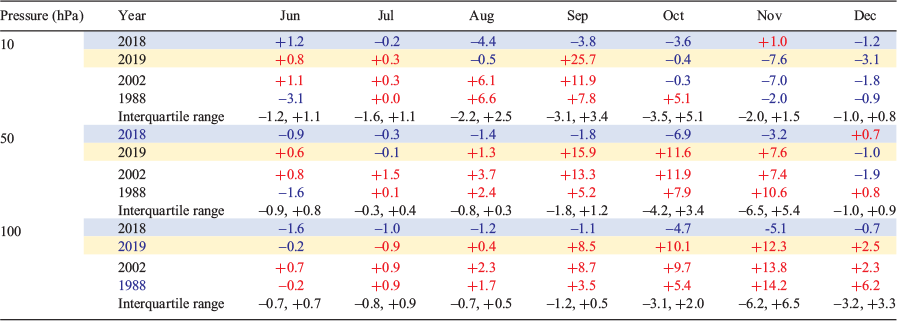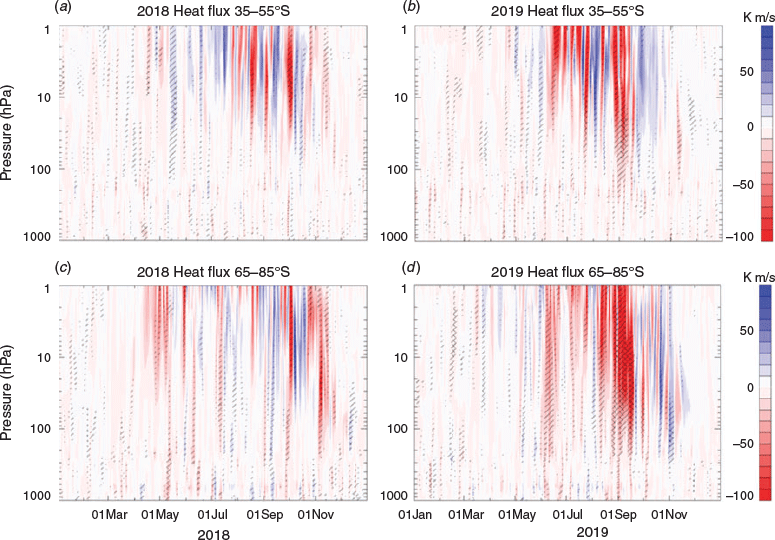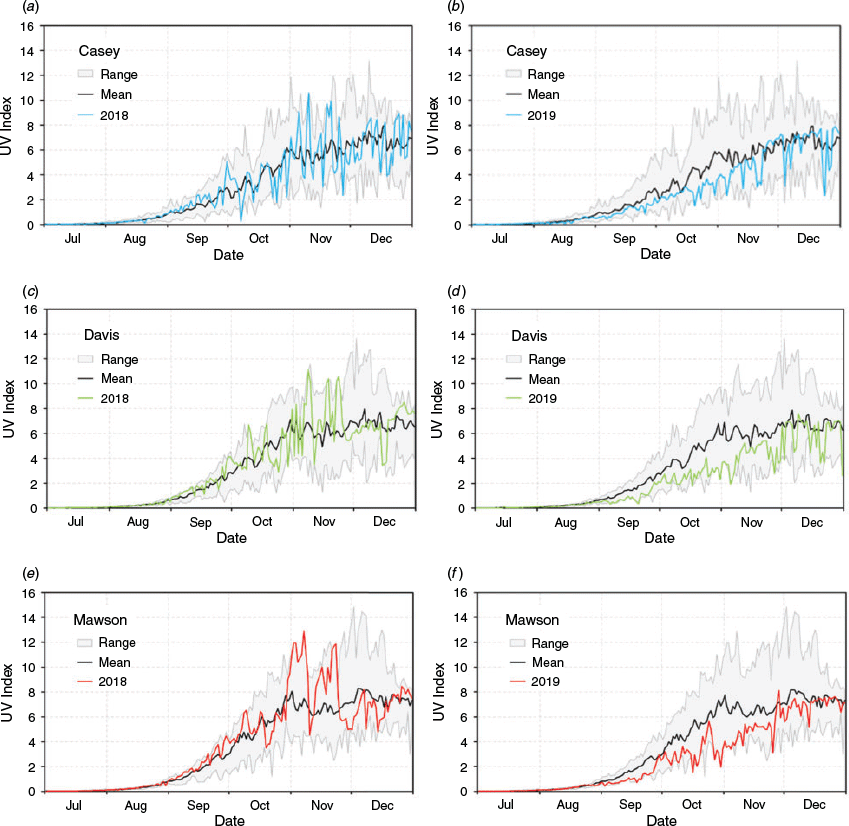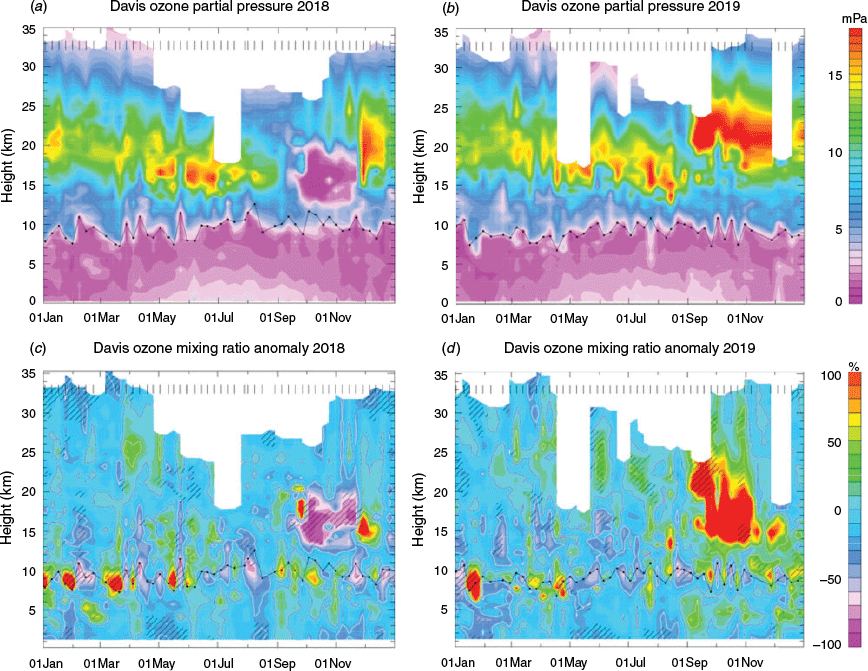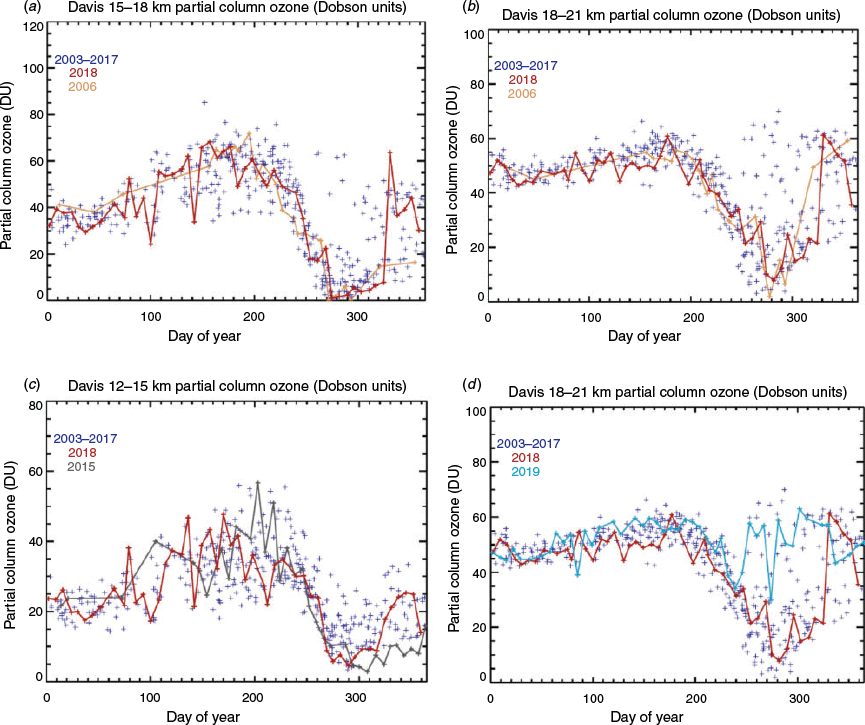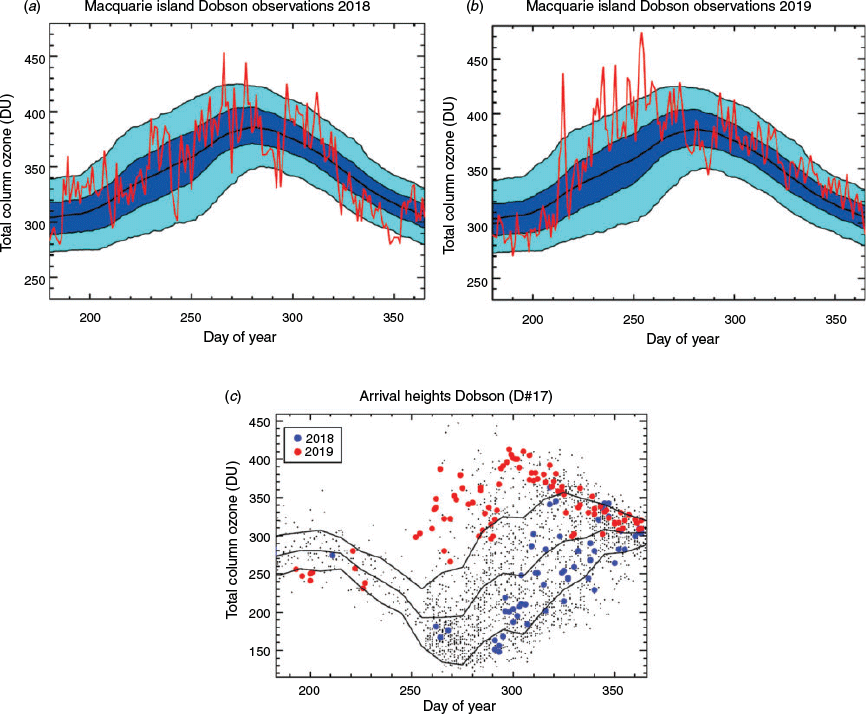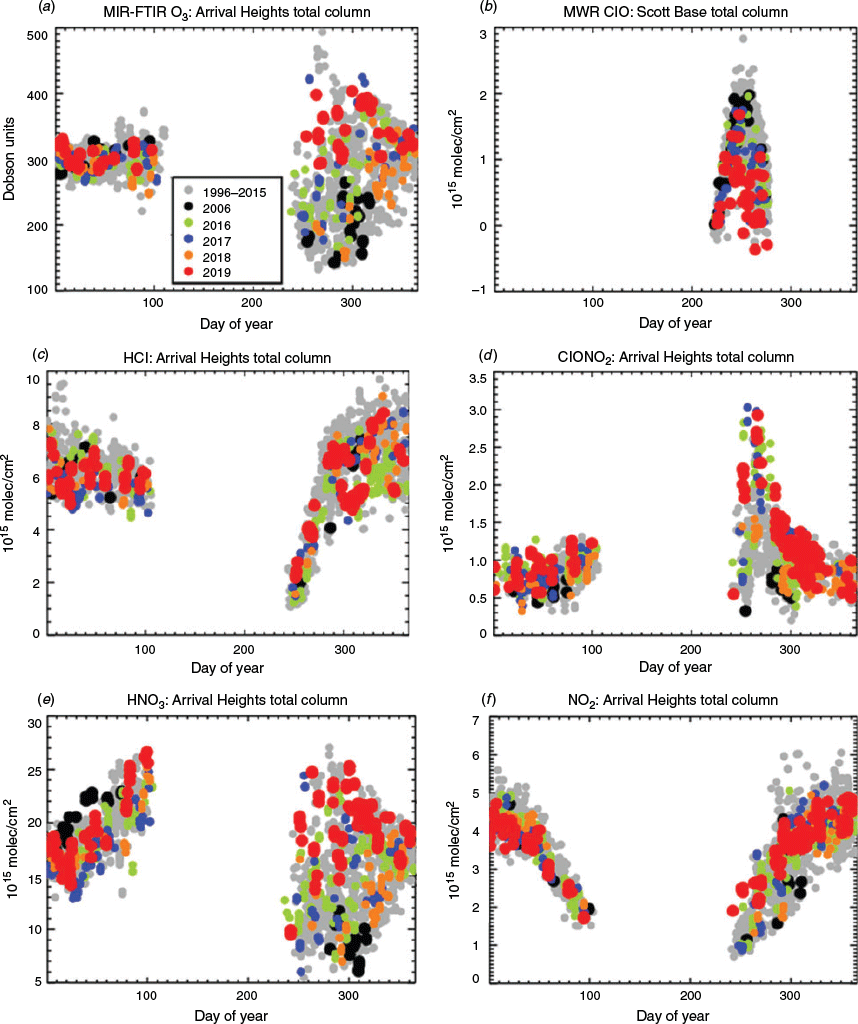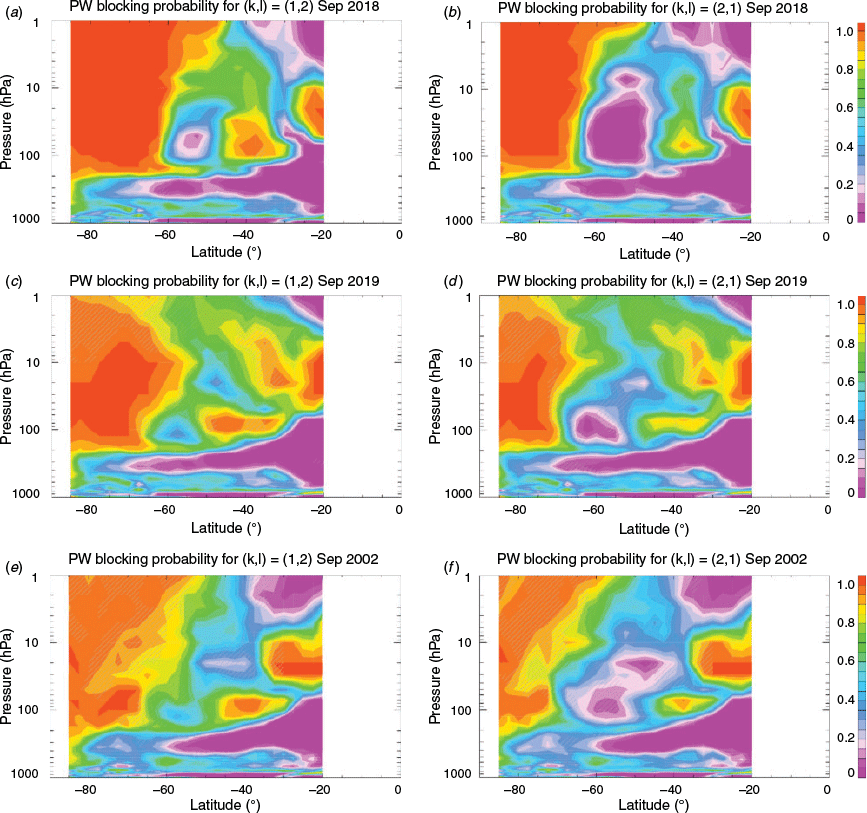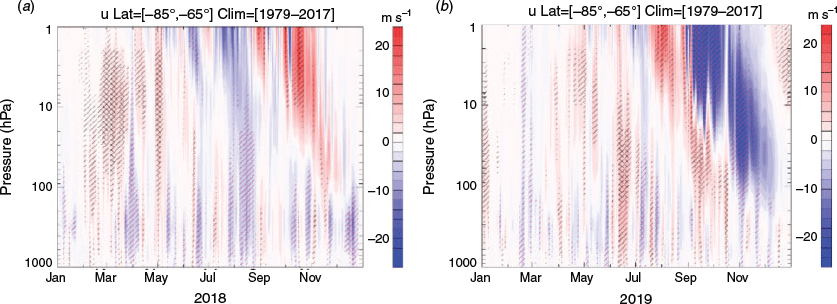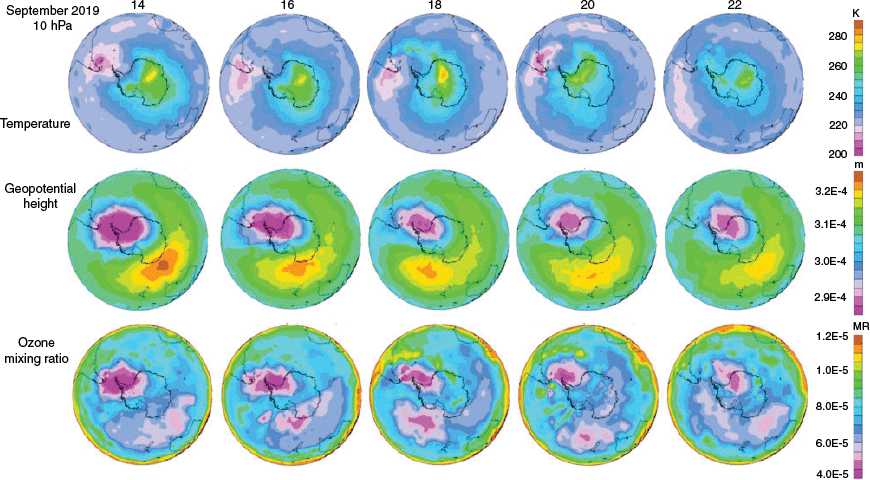The Antarctic ozone hole during 2018 and 2019
Andrew R. Klekociuk A H , Matthew B. Tully B , Paul B. Krummel C , Stuart I. Henderson D , Dan Smale
A H , Matthew B. Tully B , Paul B. Krummel C , Stuart I. Henderson D , Dan Smale  E , Richard Querel E , Sylvia Nichol F , Simon P. Alexander A , Paul J. Fraser C and Gerald Nedoluha G
E , Richard Querel E , Sylvia Nichol F , Simon P. Alexander A , Paul J. Fraser C and Gerald Nedoluha G
A Australian Antarctic Division, Department of Agriculture, Water and the Environment, Kingston, Tasmania, Australia.
B Bureau of Meteorology, Melbourne, Victoria, Australia.
C Climate Science Centre, CSIRO Oceans and Atmosphere, Aspendale, Victoria, Australia.
D Australian Radiation Protection and Nuclear Safety Agency, Yallambie, Victoria, Australia.
E National Institute of Water & Atmospheric Research, Lauder, New Zealand.
F National Institute of Water & Atmospheric Research, Wellington, New Zealand.
G Naval Research Laboratory, Washington, DC, USA.
H Corresponding author. Email: andrew.klekociuk@awe.gov.au
Journal of Southern Hemisphere Earth Systems Science 71(1) 66-91 https://doi.org/10.1071/ES20010
Submitted: 13 October 2020 Accepted: 8 February 2021 Published: 16 March 2021
Journal Compilation © BoM 2021 Open Access CC BY-NC-ND
Abstract
While the Montreal Protocol is reducing stratospheric ozone loss, recent increases in some ozone depleting substance (ODS) emissions have been identified that may impact southern hemisphere climate systems. In this study, we discuss characteristics of the 2018 and 2019 Antarctic ozone holes using surface in situ, satellite and reanalysis data to gain a better understanding of recent ozone variability. These ozone holes had strongly contrasting characteristics. In 2018, the Antarctic stratospheric vortex was relatively stable and cold in comparison to most years of the prior decade. This resulted in a large and persistent ozone hole that ranked in the upper-tercile of metrics quantifying Antarctic ozone depletion. In contrast, strong stratospheric warming in the spring of 2019 curtailed the development of the ozone hole, causing it to be anomalously small and of similar size to ozone holes in the 1980s. As known from previous studies, the ability of planetary waves to propagate into the stratosphere at high latitudes is an important factor that influences temperatures of the polar vortex and the overall amount of ozone loss in any particular year. Disturbance and warming of the vortex by strong planetary wave activity were the dominant factors in the small 2019 ozone hole. In contrast, planetary wave disturbances to the vortex in the winter–spring of 2018 were much weaker than in 2019. These results increase our understanding of the impact of Montreal Protocol controls on ODS and the effects of Antarctic ozone on the southern hemisphere climate system.
Keywords: Antarctica, climate, meteorology, Montreal Protocol, ozone, ozone depletion, ozone hole metrics, southern hemisphere, stratosphere.
1 Introduction
Assessing the behaviour of the annual Antarctic ozone hole continues to be an important aspect of monitoring the impact of Montreal Protocol controls on ozone depleting substances (ODS) and for observing the effects of Antarctic ozone on the interactions between components of the climate system (Goyal et al. 2019; Lickley et al. 2020; Solomon et al. 2020). While the Montreal Protocol is working to reduce stratospheric ozone loss (WMO 2018), recent increases in some ODS emissions have been identified (Montzka et al. 2018; Claxton et al. 2019; Fang et al. 2019; Rigby et al. 2019) with likely effects on recovery of Antarctic ozone (Dhomse et al. 2019). At the same time, the accuracy in evaluating ozone trends is influenced by variability in stratospheric conditions and their relationship to large-scale climate modes (Zhang et al. 2017; Chipperfield et al. 2018; Maycock et al. 2018; Ball et al. 2019).
The processes leading to ozone depletion from ODS primarily take place inside the Antarctic stratospheric polar vortex from late winter through to early summer, with peak ozone loss occurring in spring (Solomon et al. 1986). The overall level of ozone depletion is strongly dependent on temperatures inside the vortex, as well as the availability of chlorinated and brominated ODS (Langematz et al. 2018). This primarily arises because of the central role played by Polar Stratospheric Cloud (PSC) particles, which form in the lower polar stratosphere when temperatures fall below ~190 K, in the process of transforming ODS into forms that destroy ozone. Years when the vortex is cold and stable during winter and spring result in the greatest ozone loss for a given level of ODS (Zhang et al. 2017). Rapid warming of the vortex occurs when the dynamical barrier below or around the vortex is weakened by the upward propagation of atmospheric waves – primarily the planetary-scale Rossby waves. The origin of these disturbances may be from remote Antarctica, driven by large-scale deep convection or land–sea temperature contrasts and influenced by meanderings of sub-tropical and mid-latitude circulation (Peters and Waugh 2003). Weakening of the vortex leads to intrusion of warmer air from lower latitudes or removal of air that has been preconditioned for ozone depletion (i.e. chemically processed by heterogeneous reactions on PSC particles and other aerosols (Haigh and Roscoe 2009)). Both these effects can curtail the ozone depletion process.
Climate model simulations and observational data have shown robustly that Antarctic ozone depletion leads to cooling of the stratosphere, which promotes circulation changes that couple downward to the surface on time-scales of weeks to months, affecting conditions mainly in summer (Polvani et al. 2011; Bandoro et al. 2014; Li et al. 2016). This coupling affects not only the Antarctic surface but wide areas of the southern hemisphere (Thompson and Solomon 2002). It is manifested primarily as a tendency for the Southern Annular Mode (SAM) to be forced into a more positive state, with lower surface pressures at sub-polar latitudes (around 65°S), higher pressures at mid-latitudes (around 40°S) and a general strengthening and poleward contraction of the westerly wind belt over the Southern Ocean (Son et al. 2010; Thompson et al. 2011). The SAM is the primary mode of surface climate variability in the Antarctic and Southern Ocean region (Gong and Wang 1999). It not only responds to stratospheric ozone change but also to the effects of tropospheric global warming (Wang and Cai 2013) and other large-scale climate modes, including the El Niño Southern Oscillation (ENSO) and the Indian Ocean Dipole (IOD) (Fogt and Marshall 2020). Dennison et al. (2015) showed that the persistence and variability of the stratospheric SAM is enhanced by ozone depletion, and this leads to longer lasting coupling between the stratosphere and troposphere. Lim et al. (2019) found that weakening of the Antarctic vortex tended to enhance fire conditions in eastern Australia. A series of unprecedented climate extremes occurred in the southern hemisphere during late 2019 and early 2020, which were enhanced by stratospheric influences (Lim et al. 2020). The extremes included widespread heatwaves and severe bushfires in Australia (Davey and Sarre 2020) and South America (Blunden and Arndt 2020) and record high temperatures in Antarctica (Robinson et al. 2020). Associated with these conditions was a generally strong negative phase of the SAM and the most strongly positive IOD since 1997 (Blunden and Arndt 2019). In the Pacific, the ENSO was in a weak La Niña phase. Extreme conditions developed in the Antarctic stratosphere in September 2019, with a minor Sudden Stratospheric Warming (SSW; Lim et al. 2020; Newman et al. 2020; Rao et al. 2020) resulting in one of the smallest ozone holes since the 1980s (Kramarova et al. 2020; Wargan et al. 2020). Conditions that favoured the development of the SSW included the prevailing positive IOD phase, warm central Pacific sea surface temperatures, the easterly phase of the Quasi-Biennial Oscillation (QBO) and high latitude tropospheric patterns, including weak zonal wind anomalies in the Indian and Pacific Ocean sectors (Milinevsky et al. 2019; Lim et al. 2020; Rao et al. 2020; Shen et al. 2020). Downward coupling from the SSW is implicated in enhancing surface temperatures during summer in Antarctica (Scambos and Stammerjohn 2020) and Australia (Lim et al. 2020).
Southern hemisphere conditions during the latter half of 2018 and early 2019 were much less marked compared with the following year. While temperatures across parts of the southern hemisphere were above normal, heatwave conditions were only notable in eastern Australia (Blunden and Arndt 2019). Generally, ENSO-neutral conditions persisted until November and then moved into a weak La Niña. While there were significant fires in parts of Australia, overall fire activity in the southern hemisphere was below the 2003–2017 average. The IOD was in a positive phase for much of the year, although this was less marked than in 2019. The SAM was in a positive phase during spring and early summer, and this moderated the drying effect of the positive IOD phase in eastern Australia. The Antarctic ozone hole was close to average in size for this century, while the temperature of the stratospheric vortex was generally below average during spring (Kramarova et al. 2019).
To further build on previous analyses, we provide here additional information on the Antarctic ozone holes of 2018 and 2019, and compare and contrast their behaviour using a variety of observations, including measurements made at sites in East Antarctica and the Southern Ocean operated by Australia and New Zealand researchers and collaborators. This continues a series of analyses of annual Antarctica ozone holes, which has covered the period since 2007 (Klekociuk et al. 2019 and references therein; Tully et al. 2019; Krummel et al. 2019b). The outline of this paper is as follows. In Section 2 we describe the data and methods used. In Section 3, we provide metrics for the 2018–2019 ozone holes and discuss the characteristics of the metrics in terms of prevailing meteorological factors and observed effects at specific measurement sites. A summary of our findings and conclusions are presented in Section 4. The methods used to obtain the ozone hole metrics are described in Klekociuk et al. 2019 and references therein; Tully et al. 2019; Appendix A.
2 Materials and methods
2.1 In situ measurements and ground-based remote sensing
2.1.1 Ozonesondes
To characterise the vertical distribution of ozone within the ozone hole, we used in situ measurements of ozone mixing ratio obtained from ozonesonde balloons that were flown approximately weekly at Davis Research Station, Antarctica (68.57°S, 77.97°E; Fig. 1) during 2018 and 2019. The equipment for each ozonesonde consisted of a Science Pump Corporation ECC6A electrochemical cell that were flown under a 1200 g balloon. The sensing cathode solution (3.0 cm3) consisted of 1% potassium iodide (weight per volume) with potassium bromate and buffers, and the anode solution (1.5 cm3) was a saturated potassium iodide solution (Johnson et al. 2002). These general specifications and operation the ozonesonde equipment (including the calibration method) have been maintained since the start of the program at Davis in February 2003, with the only exception being the type of radiosonde equipment used (RS80 prior to March 2006, RS92 until February 2019 and currently RS41). Here we used 10 s cadence measurements (obtained at approximately 50 m height intervals) that are archived at WOUDC (2020).
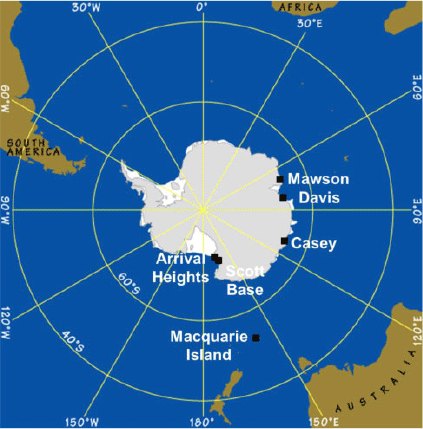
|
2.1.2 Ultraviolet radiation measurements
The Australian Radiation Protection and Nuclear Safety Agency (ARPANSA) monitors the levels of solar ultraviolet radiation (UVR) at Australia’s Antarctic research stations (Fig. 1) – Casey (66.28°S, 110.53°E), Davis and Mawson (67.60°S, 62.87°E) – using broadband UVR detectors (UVBiometer Model 501, Solar Light Co., Philadelphia, USA). The spectral responses of these detectors are similar to that of human skin, described by the erythema spectral weighting function (CIE 2020). The recorded values of erythemally effective solar UVR were averaged over a period of 10 min and converted to UV Index values before being reported. One UV Index unit is defined to be equivalent to an erythemally effective irradiance of 25 mW m−2 (WHO 2002). The maximum 10-min average UVR intensity value recorded each day was reported as the UV Index.
Prior to deployment, the broadband radiometers were calibrated at ARPANSA by comparison with simultaneous solar UVR measurements from a spectroradiometer (model DTMc300, Bentham Instruments Limited, Reading, UK). The spectroradiometer was calibrated for irradiance using a 1000 W quartz tungsten halogen lamp traceable to the National Measurement Institute (Australia) and its wavelength calibration was determined with reference to the UV spectral lines of a mercury lamp.
2.1.3 Trace gas measurements at Arrival Heights and Scott Base
At Arrival Heights in Antarctica (77.9°S, 166.8°E), a mid-infrared (MIR) Fourier transform spectrometer (FTS) is used to obtain gas-phase total column abundances for a variety of species relevant to ozone chemistry from solar observations (Kohlhepp et al. 2012), including ozone (O3), hydrochloric acid (HCl), chlorine nitrate (ClONO2), nitric acid (HNO3) and nitrogen dioxide (NO2). FTS measurements have been made between late August and early April annually since 1996. Additionally, measurements of stratospheric chlorine monoxide (ClO) have been taken at Scott Base (77.85°S, 166.76°E) using a microwave radiometer since 1996 (Nedoluha et al. 2016). Both the FTS and microwave radiometer measurements are made under the auspices of the Network for the Detection of Atmospheric Composition Change (De Mazière et al. 2018; NDACC 2020).
2.1.4 Total column ozone measurements at Macquarie Island
Total column ozone measurements are made at Macquarie Island (54.50°S, 158.95°E) year-round, several times a day using a Dobson spectrophotometer, continuing a time series originating in 1957. Data are archived by WOUDC (2020) and NDACC (2020). Macquarie Island is normally situated outside the vortex near its northern edge. The only other active sites at a similar latitude measuring total column ozone are in South America: Ushuaia (54.8°S, 68.30°W), Punta Arenas (53.16°S, 70.92°E) and Rio Gallegos (51.62°S, 69.21°W). Here we only consider the Macquarie Island data in order to examine ozone variations in the Australian longitude sector.
2.2 Satellite measurements
2.2.1 Total column ozone
We used daily global gridded (level 3) total column ozone data from three separate satellite-borne instruments to evaluate metrics of the ozone hole using the methods described in Appendix A: (a) the Total Ozone Mapping Spectrometer (TOMS), (b) the Ozone Monitoring Instrument (OMI) and (c) the Ozone Mapping and Profiler Suite (OMPS). These instruments provided/provide ozone information from sun-synchronous orbits using nadir measurements of backscattered (by the atmosphere) solar UV. The time intervals, spatial resolutions and versions of the total column ozone data used in our analysis are provided in Appendix A. TOMS instruments operated on three satellites: Nimbus 7 (October 1978–May 1993), Meteor 3 (August 1991–November 1994) and Earth Probe (July 1996–December 2005 (McPeters et al. 1998). The OMI instrument is on the Earth Observing Satellite Aura, operational from August 2004 (Kroon et al. 2008; McPeters et al. 2008). OMPS is a three-part instrument on the Suomi National Polar-orbiting Partnership satellite, operational from October 2011 (Bai et al. 2013). Specific issues have affected data quality from some of these instruments. Earth Probe TOMS suffered from a progressive degradation in measurement quality, which has been corrected empirically (Antón et al. 2010). The OMI retrievals account for an unintended obstruction in its field of view and performance issues in a particular viewing direction (Dobber and Braak 2010).
2.2.2 Vertically resolved measurements
We used version 4.2 level 2 swath data from the Microwave Limb Sounder on the Aura satellite (Aura/MLS) for air temperature, geopotential height, nitrous oxide (N2O) and ozone mixing ratios on pressure levels to assess temperature and composition anomalies over the Antarctic region. The Aura/MLS data were selected according to quality control thresholds (NASA 2020a). Daily temperature data were interpolated to a uniform geometric height grid with 1 km spacing and averaged over latitudes poleward of 60°S. The ozone and N2O data (which are provided in the level 2 product with reference to an absolute molar scale based on calibrated in situ measurements) were interpolated to specific isentropic levels and spatially averaged within the ‘inner vortex edge’ region (Lee et al. 2001; Roscoe et al. 2012) defined in the MLS Derived Meteorological Product (DMP) dataset (NASA 2020b) with the Modern-Era Retrospective analysis for Research and Applications version 2 reanalysis (MERRA-2; Gelaro et al. 2017). As noted by Manney et al. (2007), identification of the vortex edge can be problematic under certain circumstances, particularly outside of winter, and mixing ratio estimates within this region may not necessarily accurately reflect the broad average of the inner vortex.
2.3 Reanalysis data
We use data from three reanalyses to provide information on the atmospheric state in the southern hemisphere during 2018: the European Centre for Medium-Range Weather Forecasts (ECMWF) fifth generation reanalysis ERA5 (Hersbach et al. 2020), MERRA-2 and the Multi-Sensor Reanalysis version 2 (MSR2; van der A et al. 2015). ERA5 was used to derive the meridional eddy heat flux T*u* as a function of latitude and pressure (where T and u are the air temperature and zonal wind speed, respectively, and * denotes the zonal anomaly), which is a proxy for the upward energy propagation by planetary-scale (Rossby) waves. We also used ERA5 to evaluate a proxy for the size of the stratospheric polar vortex as the area enclosed by contours of potential vorticity on particular isentropic surfaces (Braathen and Proffitt 2000). A widely used method of determining the extent of the vortex is that of Nash et al. (1996). While estimates of vortex area are problematic, and alternative methods have been developed (Roscoe et al. 2012; Smith and McDonald 2014), the area proxy used here shows similar seasonal and inter-annual behaviour to the that obtained with the Nash et al. (1996) method (not shown) and is more readily applied.
MERRA-2 was used to evaluate the daily climatology of ozone mixing ratio as a function of height for Davis over 2008–2017 to examine the ozone anomaly in the ozonesonde measurements during 2018 and 2019. The MSR2 data (KNMI 2020) consist of daily total column ozone estimates constructed from a data assimilation method applied to satellite and ground-based total column ozone measurements. These data, along with ERA5 total column ozone data, were used to evaluate the annual ozone hole metrics using the same methods that were applied to the satellite total column ozone data (Appendix A). For the period 2000–2006, the ERA5.1 special run (Adrian et al. 2020) was used for evaluation of the ozone hole metrics as discussed in Appendix A.
Both ERA5 and MERRA-2 are regarded as providing a suitable representation of temperatures and dynamics in the lower stratosphere of the southern hemisphere, particularly in the past decade when increased assimilation of observations, particularly from Global Positioning System occultation profiles, has reduced temperatures biases (Friedrich et al. 2017; Adrian et al. 2020). However strong stratospheric disturbances been shown to provide challenges for the representation of the vertical temperature structure and chemical mixing ratios in modern reanalyses, particularly in the upper levels (Manney et al. 2008; Manney et al. 2009).
3 Results and discussion
3.1 Metrics for the 2018 ozone hole
Fig. 2a shows daily minimum total column ozone south of 35°S (Metric 4 in Table 1). In 2018, the first excursions below the 220 Dobson Unit (DU) contour, which provides a threshold to define the ozone hole (Uchino et al. 1999; Newman et al. 2004; Bodeker et al. 2005), occurred sporadically in the second half of July and again in early August, which was typical of recent years. These variations potentially relate to effects from variability in the size and shape of the ‘collar’ region of the vortex (Newman et al. 2004), particularly due to the mixing of air within the vortex with ozone-poor air at the vortex edge, where photolytic ozone destruction was only just beginning due to the return of sunlight at the end of the polar night. Additionally, variability in the size of the ozone hole during its formation can be influenced by chemical changes associated with the enhancement of PSCs by mesoscale waves, or small-scale effects from gravity waves (Alexander et al. 2013). The metric remained below 220 DU from the second week of August until the ozone hole closed in the first week of December. The tendency in this metric from August until mid-September was similar to the long-term (1979–2017) mean (Fig. 2a), after which the metric remained below average for the remainder of the ozone hole period. It reached a relatively deep minimum of around 102 DU (ranking 14th lowest since 1979) during early October. Up until early November, the time series of this metric was similar to that observed in 2015 and was at or near the lowest observed values from mid-October to early November.
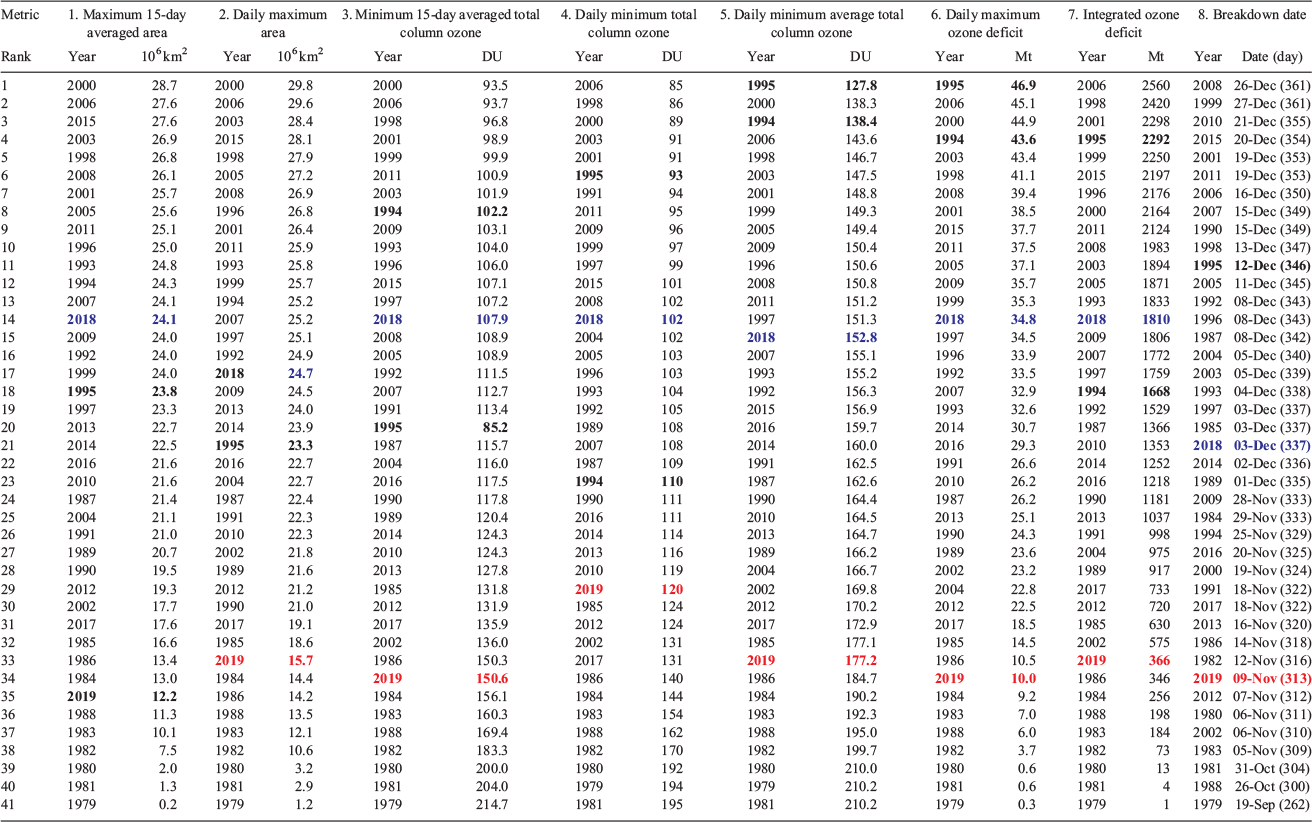
|
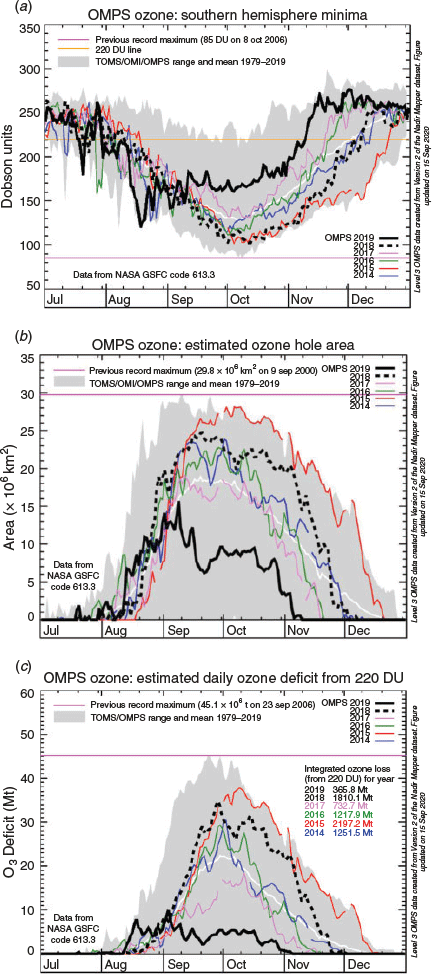
|
Fig. 2b shows the daily Antarctic ozone hole area (the area within the 220 DU contour; Metric 2 in Table 1) during the 2018 season. The maximum daily area of the ozone hole (24.7 million km2 (Mkm2) on 20 September) was the 17th largest in our analysis and ~86% of the largest area observed in 2000. The maximum 15-day average ozone hole area (Metric 1 of Table 1) for 2018 (24.1 Mkm2) was the 14th largest hole in our analysis, larger than the median value for 1979–2017 (22.1 Mkm2). These statistics indicate that the 2018 ozone hole was on the larger side of ‘middle of the pack’. Notably, it was also larger compared to the ozone holes of the preceding 5 years, except for 2015 (Table 1) when ozone depletion was aided by volcanic aerosols and the absence of strong dynamical disturbance of the polar vortex (Stone et al. 2017).
The ozone hole area time series for 2018 shown in Fig. 2b exhibited specific disturbed periods during the austral spring, which are discussed in Section 3.3 below. The ozone hole grew rapidly in size from mid-August and peaked in area on 20 September, about 2 weeks earlier than the timing of the lowest total column value (Fig. 2a). Late September and early October saw two small warming events which reduced the ozone hole area from around 24 Mkm2 to around 22 Mkm2. The ozone hole area remained in the 20–22 Mkm2 range for the remainder of October and the first week of November. From early November, a generally stronger decline in area began, which was punctuated by brief increases around the 10, 20 and 28 November. The recovery during November took place during the overall warming of the mid- to lower stratosphere discussed in Section 3.3.
Fig. 2c shows the daily maximum ozone deficit in the Antarctic ozone hole with respect to 220 DU (Metric 6 of Table 1), which is a function of both ozone hole depth and area. The maximum daily ozone deficit in 2018 was 34.8 million tonnes (Mt) in late September, the 14th largest deficit. Integrated over the whole ozone hole season, the total ozone deficit (the sum of the daily ozone deficits) in 2018 based on OMPS data was approximately 1810 Mt. This is the 14th largest cumulative ozone deficit analysed and ~71% of the value for 2006, which is the maximum annual deficit in Table 1.
3.2 Metrics for the 2019 ozone hole
The formation of the 2019 ozone hole became apparent from mid-July to early August, similar to 2018. As seen in Fig. 2a, daily minimum total column ozone values (Metric 2) stayed consistently below the 220 DU threshold from late July. This was slightly earlier than in 2018. The metric rapidly dropped from early August and at times fell below the climatological range of the satellite record up to the third week of August. After reaching a minimum of 120 DU on 18 August, the metric started to trend back towards the climatological average. By mid-September the minimum column value was noticeably different from the behaviour in the recent years (Fig. 2a). In the second week of November, the metric crossed the 220 DU threshold, resulting in one of the earliest breakdown dates of the ozone hole in the observational record (Metric 8 of Table 1).
Coincident with falling ozone concentrations in the sunlit portion of the polar cap, the daily area metric (Fig. 2b) rapidly rose in early August and was above the climatological mean for most of the month. By early September the growth of the hole started to wane. However, the area reached a brief peak on 8 September of 15.7 Mkm2, ranking Metric 2 the 9th smallest in our analysis. In the following two weeks, the overall size of the ozone hole decreased and reached a local minimum around 21 September. Subsequently there was a period of slight growth to early October. This was followed by a period of fairly stable size, although this was about half the climatological mean at that time. From the third week of October, there was an overall decline in the metric until breakdown.
Consistent with the growth in ozone depletion in early August, the daily ozone deficit (Fig. 2c; Metric 6) showed a rapid early rise to levels that were at the maximum of the climatological record up to 18 August. After this, there was only limited further growth. The peak deficit of 10 Mt was reached on 3 September, ranking this metric 34th in our analysis and comparable with values observed in the mid-1980s. The subsequent behaviour of Metric 6 tended to follow a similar variation to the area metric (Metric 4; Fig. 2b) with a period of relative stability from late September to mid-October, before a final general decline.
Overall, the behaviour of the 2019 ozone hole strongly contrasted with that of 2018. The early growth in 2019 was generally stronger than in 2018, and indeed the early size of the 2019 ozone hole was near the climatological maximum. However, disturbances to the polar vortex that began in mid-August, becoming exceptional in September (as discussed in Section 3.3 below), significantly curtailed the ozone depletion process. These disturbances generally abated by early October. By this time, the 2019 ozone hole was well below the climatological mean and was one of the smallest observed since the early years of the observational record. It is useful to note that the metrics for 2019 in Table 1 are closely ranked to some other years of the preceding decade, particularly 2017, which is discussed in detail by Klekociuk et al. (2019). We return to this point in Section 3.5.
The annual time series of Metrics 4, 1 and 7 of Table 1 are presented in Fig. 3a, b and c, respectively, which further highlights the differences between 2018 and 2019 and how exceptional 2019 was in comparison with earlier years. While there are obvious differences in the annual metrics calculated using the different data sets (the origin of which is discussed in Appendix A), particularly for 2019, the ozone hole in 2018 showed characteristics similar to 2007 and 2009 (Table 1) when ozone depletion was aided by relatively low stratospheric temperatures (Tully et al. 2008; Tully et al. 2011). In contrast, the 2019 ozone hole was similarly anomalous to 2002 and 1988 when the stratosphere was strongly disturbed (Newman and Nash 2005; Roscoe et al. 2005).
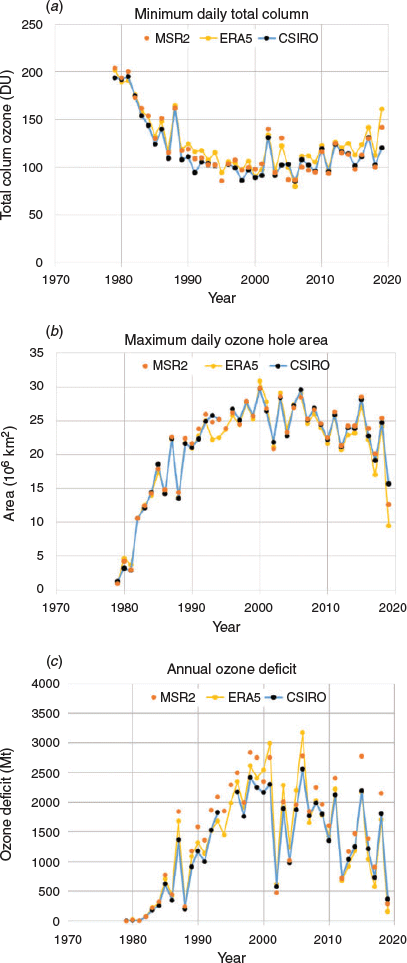
|
3.3 Stratospheric conditions in 2018 and 2019
Table 2 presents monthly ERA5 polar cap temperature anomalies at three pressure levels (10 hPa – mid-stratosphere, 50 hPa – lower stratosphere and 100 hPa – near tropopause) for June–December. Anomalies for 2018 and 2019 are provided, and for the exceptional years of 2002 and 1988. The winter months (June–August) of 2018 and 2019 were not particularly outstanding compared with the interquartile range, although temperatures in the later part of the 2018 winter tended to be well below average. The exceptionally warm stratosphere in spring and early summer of 2019 is clear and shows a time–height progression similar to the anomalous behaviour in 2002 (Table 2). However, unlike 2019, the 2002 winter was anomalously warm for most of the period. The 2019 warming became prominent in September, particularly at 10 hPa, and progressed to strongly influence the lower levels by mid–late summer (Kramarova et al. 2020; Lim et al. 2020; Newman et al. 2020). As can be seen in Fig. B1, the potential extent and duration of PSCs in the polar cap was likely much reduced in 2019 (Fig. B1b) compared with 2018 (Fig. B1a), not only because of the strong warming in spring but because of above average temperatures in the early part of the winter.
Fig. 4 shows the height-time behaviour of the daily Aura/MLS temperature anomaly over the southern polar cap for from January 2017 to July 2020. Obvious features in Fig. 4 are the warm and cool anomalies that descend with time, generally starting in the upper mesosphere (~90 km) in early autumn (March) and reaching the lower stratosphere by early summer (November). These anomalies have been discussed for specific years (e.g. 2017 is discussed in Klekociuk et al. 2019). As seen in 2018 (Fig. 4b), a band of below-average temperatures was situated underneath warm anomalies during spring, which contrasted with 2017 (Figs. 4a) and 2019 (Fig. 4c). The strength of the anomalies in the upper stratosphere in 2019 (towards the stratopause at ~50 km) up to mid-August was generally less marked, particularly in comparison to 2017. However, after this time, strong warming took place in the mid- and lower stratosphere. This appeared to persist through to March 2020 (Fig. 4d) and possibly longer near the tropopause (~10 km height). This anomaly sometimes reached the maximum daily extreme in the Aura/MLS climatology (cross-hatching in Fig. 4c). Indeed, the ERA5 monthly average temperature anomaly at 50 hPa in September was +15.9 K, which is the largest in the 1979–2019 climatology (Table 2). Above this warm anomaly was a broad region in the upper stratosphere and mesosphere of below-average temperatures, consistently at the lowest extremes of the climatology, which mostly persisted through to mid-summer.
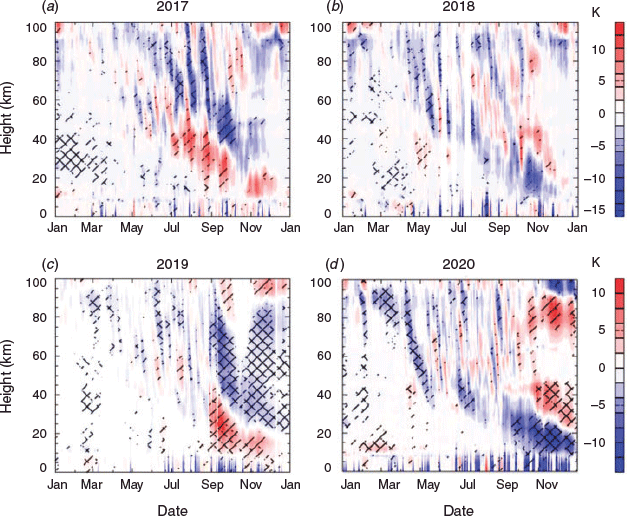
|
Fig. 5 shows the eddy heat flux as a function of time and pressure for two latitude bands in 2018 and 2019. The latitude ranges were chosen to separately show the distinction between disturbances at mid-latitudes and how they relate to the high latitudes. By examining the full vertical range of the reanalysis, some indication of the ability of the waves to propagate vertically can be gleaned. Comparing the two years in the 35–55°S band (Figs 5a and 5b), there was more prominent poleward heat transport in 2019 (i.e. greater negative heat flux indicated by the stronger red contours), particularly for July–September. This was also the case in the 65–85°S band (Figs 5c and 5d). Indeed, climatological extreme negative flux values were set during August–September 2019 (cross-hatching in Fig. 5d). The higher latitude band showed more activity in the 2018 autumn (particularly April–May) than in 2019 and then became quieter once the vortex became established. The lower latitude band exhibited generally equatorward heat transport at higher altitudes during late September and most of October 2019 as a response to the disturbances that occurred. The strongest poleward heat flux pulses in 2018 (e.g. July–October) generally had less penetration to the higher latitudes and lower height levels than those present in 2019. This is an indication of a dynamically stronger vortex in 2018 than in 2019. The source of the contrast in activity between the two winters is further discussed in Section 3.5.
A measure of high latitude daily Rossby wave activity near the edge of polar vortex in the lower stratosphere (at 50 hPa and 60°S) is shown in Fig. 6 (Klekociuk et al. 2019). The amplitudes of geopotential height disturbances in winter–spring of 2019 were generally higher than in 2018. Of particular note were pulses of large-amplitude disturbance in early May, mid-June and for much of August–early October in 2019. These disturbances resulted in the strong warming of the lower stratosphere discussed above (Table 2). In September, the warming significantly reduced the zonal wind strength in the lower stratosphere (shown by the descending negative zonal anomaly for 2019 (Fig. B2b), which was in strong contrast to the situation at that time of year in 2018 (Fig. B2a)). This disturbance to the zonal circulation was the largest seen since the major SSW of 2002 (Newman et al. 2020). However, the warming was classified as minor as the zonal mean zonal wind at 10 hPa did not become negative. Fig. B3 shows south polar stereographic maps for temperature, geopotential height and ozone concentration at 10 hPa from Aura/MLS measurements spanning 14–22 September. The key date of the warming at 10 hPa was September 18 (Rao et al. 2020), when temperatures reached a peak across the polar cap. Around this time, the main part of the vortex (indicated by the region of low geopotential heights) was displaced towards the Antarctic Peninsula and the tip of South America and became weaker. The ozone distribution at this level showed a generally bipolar structure, suggesting separation of the upper vortex into two or more lobes. Following the SSW, the vortex became more centred on the pole and, although weaker, tended to stabilise through to late October (as indicated in the ozone hole boundary shown in the daily total column maps of Krummel et al. 2020).
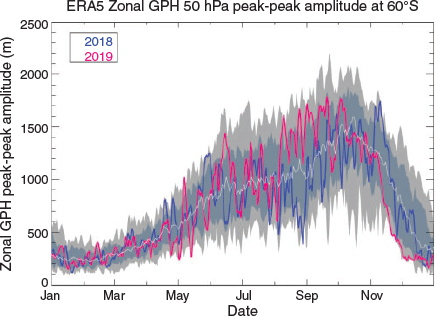
|
In terms of heat transport, the activity in early June 2019 was notably strong at high latitudes in the lower stratosphere (outside the inter-decile range; Fig. 5d). This activity occurred at the time of a peak in the amplitude of quasi-stationary planetary wave number 1 near the vortex edge (Fig. 4 of Milinevsky et al. 2019). Aside from elevated activity around the beginning of June 2018 (coinciding with the warming at high latitudes – Fig. 5c), and subsequently around the beginning of October and early November, there was generally below-average activity during most of the winter and early spring of 2018 (see also Fig. 5 of Krummel et al. 2020).
The strong planetary wave activity and poleward heat transport in the winter and spring of 2019 resulted in marked erosion of the vortex (Fig. 7). In the upper level (Fig. 7a; 850 K potential temperature (θ) or ~30 km height), the vortex area began to trend below average from late July and declined most significantly from the end of August, when it fell below the 5th percentile of the climatology since 1979, until recovering towards a typical size for this height in mid-October. At the lower level (Fig. 7b; θ = 450 K or ~18 km height) the decline began in early September and was consistently below the 5th percentile for the remainder of period until the vortex fully broke-down at this height at the end of November. In contrast to 2019, the 2018 vortex showed generally above average size for August–October in the upper level (Fig. 7a) and from mid-June–November in the lower level (Fig. 7b). The overall smaller size of the 2019 vortex compared with 2018 is apparent for θ of 850 and 450 K in Fig. 8a and b, respectively. In particular, the average vortex area for May–December 2019 on the 450 K isentrope was notably small, approaching the size evaluated for 2002. Note also that the average vortex area for 2019 at 850 K was larger than in 2002; this appears to be due to the relatively colder temperatures at this level in 2019 (Table 2).
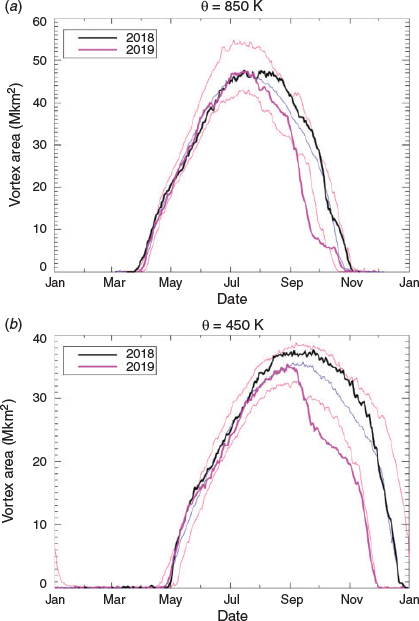
|
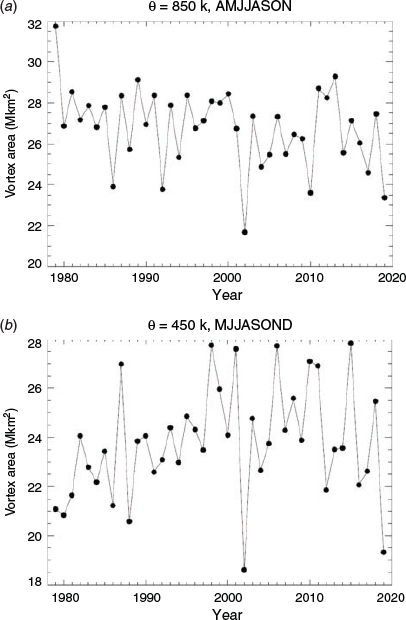
|
Monthly averages of vortex-wide mean N2O and ozone mixing ratios for θ = 450 K are shown in Fig. 9a and b, respectively. The mixing ratio of N2O in the Antarctic vortex is influenced by the phase of the QBO approximately 1 year earlier (Strahan et al. 2015; Klekociuk et al. 2019). Through a compact anti-correlation with inorganic chlorine (Cly), the N2O concentration provides a proxy for the potential influence of tropical processes on ozone depletion in the polar vortex (Strahan et al. 2014; Strahan and Douglass 2018). Despite the unusually strong disturbance to the polar vortex in September 2019, both the N2O and ozone mixing ratios for this month were not particular anomalous with respect to other years shown.
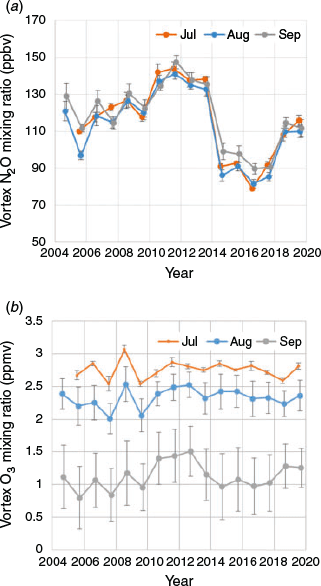
|
3.4 Observations at specific sites
Time series of the UVR Index around the coast of East Antarctica from measurements at Casey, Davis and Mawson in 2018–2019 are shown in Fig. 10. UVR levels were relatively high during spring in 2018 compared with the climatological average, particularly over late October and most of November when new extremes were sometimes set at each site. This is consistent with the combination of the relatively strong ozone depletion and large vortex over this period (as inferred from , and also evident from OMI overpass data, not shown, for each of the sites available from ESA 2020). In contrast, UVR levels were below the climatological mean for most of the period up to early December 2019 as a consequence of increased total column ozone levels (ESA 2020). New minimum observed values were set in some periods at each station. ERA5 indicates that cloud cover at the sites was generally within climatological norms for the time series in Fig. 10 (based on examination of the monthly mean cloud fraction for the nearest grid point to the sites with respect to the 2007–2019 climatology; not shown). The exceptions to this were values greater than the 90th percentile at Casey for September–November 2018, at Davis in November 2019 and at Mawson in November 2018; local UVR levels were potentially more affected by cloud during these periods, although a clear indication of this is not apparent (Fig. 9). Ozonesonde measurements at Davis (Fig. 11) showed markedly stronger depletion in the lower stratosphere for September–November 2018 than during the same months in 2019 (Fig. 11a and b, respectively). Ozone concentrations were lower than the 10th percentile of the 2008–2017 MERRA-2 climatology for Davis over most of these months in 2018 for heights 13–20 km (Fig. 11c). In contrast, concentrations were greater than the 90th percentile at times for May–November 2019, particularly above 20 km height (Fig. 11d). Generally, the appearance of increased ozone concentrations in the lower stratosphere from late November 2018 took place as the vortex edge shrank poleward of Davis and UVR levels decreased to be closer to the long-term mean (Fig. 10b). In 2019, the edge of the ozone hole moved poleward from early September. This produced the strong ozone enhancement apparent in Figure 11d (see figures in Appendix A of Krummel et al. (2019a)) and the lack of a clear influence of the ozone hole, unlike 2018 (Fig. 11c).
For June–August 2019, Davis was generally inside the vortex edge in the lower stratosphere (not shown); this was also the case during these months in 2018. In these months, generally lower mixing ratios were measured in 2018, with higher values in 2019. This behaviour is consistent with vortex-wide mixing ratio time series shown in Fig. 9b. Over the first half of October 2018, ozone destruction was close to complete at Davis in the height range 14–17 km (Fig. 12a). By contrast in the same time period in 2019, there is no indication of ozone loss within this altitude range (Fig. 12b) and estimates of total column ozone derived from the profiles were approximately twice the 2018 values.
The much earlier weakening and reduction in size of the polar vortex in 2019 (Figs 5−7) resulted in enhanced transport of ozone-rich air from lower latitudes above 20 km (see also Fig. 11). Comparison of the evolution of specific partial ozone columns above Davis is shown in Fig. 13. Over the 15–18 km height range (Fig. 13a), 2018 was comparable with 2006, when the strongest depletion was observed at Davis, with values near zero at the beginning of October in both years. Similar seasonal variations in 2018 and 2006 occurred for the 18–21 km partial column (Fig. 13b), at least up to late October (~ day 300). However, the 18–21 km values in 2018 did not reach the extreme lows (less than 5 DU) measured in 2006 or 2009 (not shown). Similarly, the 12–15 km partial ozone column at Davis in 2018 reached low values that were comparable to the most extreme years in the record (Fig. 13c). An interesting contrast is provided with 2015 in which ozone loss in the lower stratosphere was sustained into December due to enhanced levels of aerosols resulting from the Calbuco volcanic eruption and the relative stability of the polar vortex (Stone et al. 2017; Tully et al. 2019). In 2019, the rate of ozone loss up to the end of August in the 18–21 km height range was consistent with 2018, but then ceased following the stratospheric warming discussed earlier (Fig. 13d).
At sub-Antarctic Macquarie Island, which generally does not lie within the polar vortex, total ozone values were well above the long-term (1987–2017) range throughout August–September in 2019 (Fig. 14), reflecting enhanced meridional transport. Daily mean values in excess of 450 DU were recorded on 10–12 September, with the highest individual Dobson measurement being 481 DU on 11 September 2019. In 2018, total ozone values at Macquarie Island were generally within the usual range, with no values below 250 DU that were associated with the large 2015 ozone hole (Tully et al. 2019). Relatively low daily mean values of 295 DU (30 July) and 301 DU (31 August) appeared to be influenced by the proximity of the ozone hole.
Further poleward, at Arrival Heights, Dobson, spectrophotometer total column ozone measurements (Fig. 14c) during the spring (days 245–305) were markedly less in 2018 (blue dots) compared with 2019 (red dots). For the FTS measurements at the site, the total column ozone retrieval at the same time of year (Fig. 15a) for 2018 (orange dots) was in lower range observed since measurements began in 1996, while values for 2019 (red dots) were at the upper observed range. The contrast between the years is apparent from October (day 275) with values near the lowest observed on particular days of the year in 2018 and at the maximum extreme at times in 2019. This panel, and the panels for other species in Fig. 15, also highlights 2006 and 2017, when the ozone hole was large (Klekociuk et al. 2019), and 2016, which was relatively small due to warm stratospheric conditions (Tully et al. 2019). Generally, the other species shown in Fig. 15 exhibited a similar contrast in the two years. The potential for ozone loss during spring depends on the availability of the chlorine reservoir compounds HCl and ClONO2, which are present due to the breakdown of halogenated source gases. Through heterogeneous reactions involving PSC particles and the background aerosols during the winter, the reservoir compounds are activated forming ClO, chlorine gas (Cl2), chlorine dioxide (OClO), and hypochlorous acid (HOCl). The partitioning of chlorine compounds into active forms, together with other forms involving activated bromine compounds, deplete ozone in catalytic cycles in the presence of sunlight (Solomon et al. 1986). Fig. 15b shows the daily difference between daytime and nighttime ClO column from measurements at Scott Base (near Arrival Heights), which indicates the amount of chlorine activation (Nedoluha et al. 2016). At night, ClO in the lower stratosphere rapidly converts to dichlorine dioxide (Cl2O2), and the measured values are small. The generally reduced ClO column in the 2019 spring compared with the other years points to lower availability of active chlorine to destroy ozone, which is consistent with the vortex being relatively warm in 2019 (see also fig. 6.14(c) of Kramarova et al. 2020). Fig. 15c and d indicate that the column abundances of both HCl and ClONO2 were generally lower in the spring of 2018 compared with 2019. This suggests that greater activation of these compounds by heterogeneous reactions occurred in 2018, which is consistent with the prevailing lower temperatures (Fig. B1a) which would favour greater available PSC surface area. An interval of reduced HCl in late October–early November 2019 (approximately days 300–320) was caused by the measurement site being situated equatorward of the ozone hole edge (see ozone maps in Appendix A of Krummel et al. 2020). The amount of gas-phase HNO3 is an indicator of PSC volume, with lower concentrations due to uptake on PSC particles. As shown in Fig. 15e, HNO3 abundance was lower in 2018 compared with 2019, which is consistent with the expected difference in PSC abundance in the two years discussed above. A further indicator of PSC processes is the abundance of gas-phase NO2 (Fig. 15f), which is reduced due to uptake by PSC particles and their sedimentation. Again, the concentration was less in 2018 compared with 2019, which is consistent with the expected difference in PSC abundance between these years.
3.5 Comparison of Rossby wave propagation in 2018 and 2019 with 2002
As noted in Section 1, during 2018 and 2019 there were distinctly different patterns of the large-scale climate modes. The patterns of tropical warming in 2019 are implicated in allowing the penetration or ducting of Rossby waves into the polar cap (Milinevsky et al. 2019; Newman et al. 2020; Rao et al. 2020), and the prevailing patterns appeared much less effective in 2018. Here we examine Rossby wave propagation conditions in the two years and compare them with conditions in 2002.
In Fig. 16 we show the probability of blocking of stationary Rossby waves as a function of pressure and latitude for September 2018, 2019 and 2002. Here we have used the method of Karami et al. (2016) to evaluate the blocking probability for waves with zonal (k) and meridional (l) wavenumbers of (k,l) = (1,2) and (2,1). These waves are ubiquitous in the southern hemisphere during winter (Hartmann 1977) and are set up by contrasts in land and ocean temperatures that persist over large areas. In the troposphere and lower stratosphere, wave 1 (2) transports momentum poleward (equatorward). In 2018 (Fig. 16a, b) there was evidently greater blocking in the stratosphere (above 100 hPa) poleward of ~60°S compared with the other years. This view is supported by Fig. 5, which shows less strong poleward heat transport into the polar cap during spring compared with 2019. Also apparent is a channel of low blocking probability emerging from the upper troposphere near ~25°S and penetrating the upper stratosphere at mid- and low latitudes. We suggest that this channel favoured the vertical propagation of tropical waves, making them less able to interact with higher latitudes. In 2019 (Fig. 16c, d) and 2002 (Fig. 16e, f), the upper levels of the polar stratosphere appeared relatively transparent to wave propagation. There was also relatively weaker blocking below ~500 hPa over latitudes 30–50°S compared with 2018. In the case of zonal wavenumber 2, this wave appeared to be more confined to the lower stratosphere in those years, where it likely had less ability to propagate away from the vortex edge. These features tend to point to the greater ability of extratopical waves originating near the surface to influence the high latitudes during the spring in 2019 and 2002. Of further note is the warming of the polar cap above 10 hPa in April–May 2018 (Fig. 5c). While this is in contrast to the situation in 2019, the warming evidently did not have an appreciable influence in preconditioning the vortex for further disturbance during the subsequent winter.
As discussed by Newman and Nash (2005), a feature of the 2002 southern hemisphere SSW was the apparent preconditioning (warming) of the stratosphere during the winter, and the occurrence of stationary and travelling wavenumber 2 Rossby waves in the spring (Klekociuk et al. 2019), which appeared to reinforce the prevailing quasi-stationary wave 1 around the time of the vortex split in late September. The influence of travelling wave 2 around the time of a large warming event in 2017 has also been noted (Klekociuk et al. 2019), although the wave amplitudes in this case were much less than in 2002. In 2019, winter temperatures in the polar upper stratosphere were colder than in 2002 (Table 2), and travelling wavenumber 2 appears to have been relatively weak (Milinevsky et al. 2019). Comparison of Fig. 16d and e suggests that propagation of at least stationary wavenumber 2 waves to high latitudes was more likely in 2002 compared with 2019, and this may have been a factor that prevented an SSW from taking place in 2019.
As is apparent from Table 1 and Fig. 3, other years over the past decade are ranked near to 2019, being 2017, 2012 and 2010. At the other extreme, 2015 and 2011 were years of large ozone holes. As highlighted by Grytsai et al. (2017), the large (small) ozone hole years tend to correspond to an eastward (westward) shift in the zonal asymmetry of the total column ozone field. The inter-annual variability in these patterns bears a relationship with tropospheric waves 1 and 3 as well as the SAM. Of note is that years of weak ozone depletion tended to show tropical warming in the central Pacific. This was the case in 2019 and 2002, with El Niño conditions prevailing, although the strong positive IOD in 2019 was likely an additional important feature (Milinevsky et al. 2019). A question still to be resolved is how emerging changes in tropical forcing are influencing stratospheric variability. A feature of 2019 was that the warming tended to take place relatively suddenly in early spring, without the preconditioning warming that occurred in 2002. In investigating the source of these differences, the timing of tropical–extratropical connections is likely to be an important consideration.
4 Summary and conclusions
We have used ground-based, in situ, satellite and reanalysis data to review characteristics of the 2018–2019 Antarctic ozone holes. Strongly contrasting behaviour was observed in Antarctic ozone depletion between these two years. During 2018, the Antarctic stratospheric vortex was relatively stable and cold, and this produced an ozone hole that was relatively large and persistent. The overall size of the 2018 ozone hole was in the upper-tercile of the 41 ozone holes that we characterised and ranked using a set of metrics based on total column ozone data. Ozone concentrations in the 15–18 km height range measured by ozonesondes at Davis were comparable with the extreme low values observed during 2006 and 2009, which were years of the greatest ozone depletion in the 16-year Davis record.
In contrast, the ozone hole of 2019 was smaller by several metrics and similar to ozone holes in the 1980s, being in the lower-tercile of our ranked metrics. Strong disturbances to the Antarctic stratosphere during August–October were a key factor that disrupted the ozone loss process. In particular, planetary wave activity in September produced strong deceleration of the zonal flow at 10 hPa that significantly eroded the vortex and resulted in a minor SSW. The strengths of the 2019 disturbances were comparable to the activity that produced a major SSW in 2002. However, the temperature of the vortex in the 2019 winter was generally colder than in 2002, and this may have been a determining factor preventing a major warming event. The strength of the wave activity produced extremely high total ozone values at sub-Antarctic Macquarie Island in August–September.
Conflicts of interest
The authors declare no conflicts of interest.
Declaration of funding
This research did not receive any specific funding.
Acknowledgements
We acknowledge the Australian Government Department of Agriculture, Water and the Environment for support of this work, and the assistance of the following people: Jeff Ayton and the Australian Antarctic Division’s Antarctic Medical Practitioners in collecting the solar UV data, Bureau of Meteorology staff in collecting surface and upper air measurements at Cape Grim, Macquarie Island and Davis, and Antarctica New Zealand expeditioners in collecting measurements at Arrival Heights and Scott Base. Measurements at Arrival Heights and Scott Base are core-funded by the National Institute of Water & Atmospheric Research through New Zealand’s Ministry of Business, Innovation and Employment. The TOMS, OMI and OMPS data used in this study were provided by the National Aeronautics and Space Administration (NASA) Goddard Space Flight Center, Atmospheric Chemistry & Dynamics Branch, Code 613.3. Aura/MLS data used in this study were acquired as part of the NASA’s Earth-Sun System Division and archived and distributed by the Goddard Earth Sciences (GES) Data and Information Services Center (DISC) Distributed Active Archive Center. MERRA-2 reanalysis data were obtained from the GES DISC (URL: https://disc.gsfc.nasa.gov). ERA5 reanalysis data were obtained from the Copernicus Climate Data Store (URL: https://cds.climate.copernicus.eu/). MSR2 data were obtained from the Tropospheric Emission Monitoring Internet Service of the European Space Agency (URL: http://www.temis.nl/protocols/O3global.html). Davis ozonesonde measurements are available from the World Ozone and Ultraviolet Radiation Data Centre (URL: https://woudc.org). Macquarie Island, Arrival Heights and Scott Base measurements are available from the Network for the Detection of Atmospheric Composition Change (URL: https://www.ndaccdemo.org/). Part of this work was performed under Project 4293 and Project 4115 of the Australian Antarctic Science program.
References
Adrian, S., Cornel, S., Julien, N., Bill, B., Berrisford, P., Rossana, D., Johannes, F., Leopold, H., Sean, H., Hans, H., Andras, H., Antje, I., Munoz-Sabater, J., Raluca, R., and Dinand, S. (2020). Global stratospheric temperature bias and other stratospheric aspects of ERA5 and ERA5.1. ECMWF Technical Memoranda 859, .| Global stratospheric temperature bias and other stratospheric aspects of ERA5 and ERA5.1.Crossref | GoogleScholarGoogle Scholar |
Alexander, S. P., Klekociuk, A. R., McDonald, A. J., and Pitts, M. C. (2013). Quantifying the role of orographic gravity waves on polar stratospheric cloud occurrence in the Antarctic and the Arctic. J. Geophys. Res. Atmos. 118, 11,493–11,507.
| Quantifying the role of orographic gravity waves on polar stratospheric cloud occurrence in the Antarctic and the Arctic.Crossref | GoogleScholarGoogle Scholar |
Antón, M., Koukouli, M. E., Kroon, M., McPeters, R. D., Labow, G. J., Balis, D., and Serrano, A. (2010). Global validation of empirically corrected EP-Total Ozone Mapping Spectrometer (TOMS) total ozone columns using Brewer and Dobson ground-based measurements. J. Geophys. Res. Atmos. 115, D19305.
| Global validation of empirically corrected EP-Total Ozone Mapping Spectrometer (TOMS) total ozone columns using Brewer and Dobson ground-based measurements.Crossref | GoogleScholarGoogle Scholar |
Bai, K., Liu, C., Shi, R., and Gao, W. (2013). Validation of the Suomi NPP Ozone Mapping and Profiler Suite total column ozone using Brewer and Dobson spectrophotometers. Atmos. Meas. Tech. Discuss 2013, 4577–4605.
| Validation of the Suomi NPP Ozone Mapping and Profiler Suite total column ozone using Brewer and Dobson spectrophotometers.Crossref | GoogleScholarGoogle Scholar |
Ball, W. T., Alsing, J., Staehelin, J., Davis, S. M., Froidevaux, L., and Peter, T. (2019). Stratospheric ozone trends for 1985–2018: sensitivity to recent large variability. Atmos. Chem. Phys. 19, 12731–12748.
| Stratospheric ozone trends for 1985–2018: sensitivity to recent large variability.Crossref | GoogleScholarGoogle Scholar |
Bandoro, J., Solomon, S., Donohoe, A., Thompson, D. W. J., and Santer, B. D. (2014). Influences of the Antarctic Ozone Hole on Southern Hemispheric Summer Climate Change. J. Climate 27, 6245–6264.
| Influences of the Antarctic Ozone Hole on Southern Hemispheric Summer Climate Change.Crossref | GoogleScholarGoogle Scholar |
Blunden, J., and Arndt, D. S. (2019). State of the Climate in 2018. Bull. Amer. Meteor. Soc. 100, Si–S306.
| State of the Climate in 2018.Crossref | GoogleScholarGoogle Scholar |
Blunden, J., and Arndt, D. S. (2020). State of the Climate in 2019. Bull. Amer. Meteor. Soc. 101, S1–S429.
| State of the Climate in 2019.Crossref | GoogleScholarGoogle Scholar |
Bodeker, G. E., Shiona, H., and Eskes, H. (2005). Indicators of Antarctic ozone depletion. Atmos. Chem. Phys. 5, 2603–2615.
| Indicators of Antarctic ozone depletion.Crossref | GoogleScholarGoogle Scholar |
Braathen, G., Proffitt, M. (2000) ‘Polar vortex climatology from the ECMWF ERA-15 data.’ Available at https://www.atmosp.physics.utoronto.ca/SPARC/SPARC2000_new/PosterSess2/SessionP2_5/Braathen/index.html
Chipperfield, M. P., Dhomse, S., Hossaini, R., Feng, W., Santee, M. L., Weber, M., Burrows, J. P., Wild, J. D., Loyola, D., and Coldewey-Egbers, M. (2018). On the Cause of Recent Variations in Lower Stratospheric Ozone. Geophys. Res. Lett. 45, 5718–5726.
| On the Cause of Recent Variations in Lower Stratospheric Ozone.Crossref | GoogleScholarGoogle Scholar |
CIE (2020) ‘Erythema reference action spectrum and standard erythema dose.’ ISO/CIE 17166:2019(E) (International Commission on Illumination: Geneva, Switzerland)
Claxton, T., Hossaini, R., Wild, O., Chipperfield, M. P., and Wilson, C. (2019). On the Regional and Seasonal Ozone Depletion Potential of Chlorinated Very Short-Lived Substances. Geophys. Res. Lett. 46, 5489–5498.
| On the Regional and Seasonal Ozone Depletion Potential of Chlorinated Very Short-Lived Substances.Crossref | GoogleScholarGoogle Scholar |
Davey, S. M., and Sarre, A. (2020). Editorial: the 2019/20 Black Summer bushfires. Aust. For. 83, 47–51.
| Editorial: the 2019/20 Black Summer bushfires.Crossref | GoogleScholarGoogle Scholar |
De Mazière, M., Thompson, A. M., Kurylo, M. J., Wild, J. D., Bernhard, G., Blumenstock, T., Braathen, G. O., Hannigan, J. W., Lambert, J. C., Leblanc, T., McGee, T. J., Nedoluha, G., Petropavlovskikh, I., Seckmeyer, G., Simon, P. C., Steinbrecht, W., and Strahan, S. E. (2018). The Network for the Detection of Atmospheric Composition Change (NDACC): history, status and perspectives. Atmos. Chem. Phys. 18, 4935–4964.
| The Network for the Detection of Atmospheric Composition Change (NDACC): history, status and perspectives.Crossref | GoogleScholarGoogle Scholar |
Dennison, F. W., McDonald, A. J., and Morgenstern, O. (2015). The effect of ozone depletion on the Southern Annular Mode and stratosphere-troposphere coupling. J. Geophys. Res. Atmos. 120, 6305–6312.
| The effect of ozone depletion on the Southern Annular Mode and stratosphere-troposphere coupling.Crossref | GoogleScholarGoogle Scholar |
Dhomse, S. S., Feng, W., Montzka, S. A., Hossaini, R., Keeble, J., Pyle, J. A., Daniel, J. S., and Chipperfield, M. P. (2019). Delay in recovery of the Antarctic ozone hole from unexpected CFC-11 emissions. Nature Comm. 10, 5781.
| Delay in recovery of the Antarctic ozone hole from unexpected CFC-11 emissions.Crossref | GoogleScholarGoogle Scholar |
Dobber, M., Braak, R. (2010) ‘Known instrumental effects that affect the OML1B product of the Ozone Monitoring Instrument on EOS Aura’ Available at https://docserver.gesdisc.eosdis.nasa.gov/repository/Mission/OMI/3.3_ScienceDataProductDocumentation/3.3.2_ProductRequirements_Designs/known_instrumental_effects_l1b_data_omi_v6.pdf [Accessed 3 September 2020].
ESA (2020) ‘Ozone overpass data based on OMI.’ Available at http://145.23.253.72/protocols/o3field/overpass_omi.html [Accessed 2 September 2020].
Fang, X., Park, S., Saito, T., Tunnicliffe, R., Ganesan, A. L., Rigby, M., Li, S., Yokouchi, Y., Fraser, P. J., Harth, C. M., Krummel, P. B., Mühle, J., O’Doherty, S., Salameh, P. K., Simmonds, P. G., Weiss, R. F., Young, D., Lunt, M. F., Manning, A. J., Gressent, A., and Prinn, R. G. (2019). Rapid increase in ozone-depleting chloroform emissions from China. Nature Geosci. 12, 89–93.
| Rapid increase in ozone-depleting chloroform emissions from China.Crossref | GoogleScholarGoogle Scholar |
Fogt, R. L., and Marshall, G. J. (2020). The Southern Annular Mode: Variability, trends, and climate impacts across the Southern Hemisphere. WIREs Climate Change 11, e652.
| The Southern Annular Mode: Variability, trends, and climate impacts across the Southern Hemisphere.Crossref | GoogleScholarGoogle Scholar |
Friedrich, L. S., McDonald, A. J., Bodeker, G. E., Cooper, K. E., Lewis, J., and Paterson, A. J. (2017). A comparison of Loon balloon observations and stratospheric reanalysis products. Atmos. Chem. Phys. 17, 855–866.
| A comparison of Loon balloon observations and stratospheric reanalysis products.Crossref | GoogleScholarGoogle Scholar |
Gelaro, R., McCarty, W., Suárez, M. J., Todling, R., Molod, A., Takacs, L., Randles, C. A., Darmenov, A., Bosilovich, M. G., Reichle, R., Wargan, K., Coy, L., Cullather, R., Draper, C., Akella, S., Buchard, V., Conaty, A., da Silva, A. M., Gu, W., Kim, G.-K., Koster, R., Lucchesi, R., Merkova, D., Nielsen, J. E., Partyka, G., Pawson, S., Putman, W., Rienecker, M., Schubert, S. D., Sienkiewicz, M., and Zhao, B. (2017). The Modern-Era Retrospective Analysis for Research and Applications, Version 2 (MERRA-2). J. Climate 30, 5419–5454.
| The Modern-Era Retrospective Analysis for Research and Applications, Version 2 (MERRA-2).Crossref | GoogleScholarGoogle Scholar |
Gong, D., and Wang, S. (1999). Definition of Antarctic Oscillation index. Geophys. Res. Lett. 26, 459–462.
| Definition of Antarctic Oscillation index.Crossref | GoogleScholarGoogle Scholar |
Goyal, R., England, M. H., Sen Gupta, A., and Jucker, M. (2019). Reduction in surface climate change achieved by the 1987 Montreal Protocol. Environ. Res. Lett. 14, 124041.
| Reduction in surface climate change achieved by the 1987 Montreal Protocol.Crossref | GoogleScholarGoogle Scholar |
Grytsai, A., Klekociuk, A., Milinevsky, G., Evtushevsky, O., and Stone, K. (2017). Evolution of the eastward shift in the quasi-stationary minimum of the Antarctic total ozone column. Atmos. Chem. Phys. 17, 1741–1758.
| Evolution of the eastward shift in the quasi-stationary minimum of the Antarctic total ozone column.Crossref | GoogleScholarGoogle Scholar |
Haigh, J. D., and Roscoe, H. K. (2009). The Final Warming Date of the Antarctic Polar Vortex and Influences on its Interannual Variability. J. Climate 22, 5809–5819.
| The Final Warming Date of the Antarctic Polar Vortex and Influences on its Interannual Variability.Crossref | GoogleScholarGoogle Scholar |
Hartmann, D. L. (1977). Stationary planetary waves in the southern hemisphere. J. Geophys. Res. (1896–1977) 82, 4930–4934.
| Stationary planetary waves in the southern hemisphere.Crossref | GoogleScholarGoogle Scholar |
Hersbach, H., Bell, B., Berrisford, P., Hirahara, S., Horányi, A., Muñoz-Sabater, J., Nicolas, J., Peubey, C., Radu, R., Schepers, D., Simmons, A., Soci, C., Abdalla, S., Abellan, X., Balsamo, G., Bechtold, P., Biavati, G., Bidlot, J., Bonavita, M., De Chiara, G., Dahlgren, P., Dee, D., Diamantakis, M., Dragani, R., Flemming, J., Forbes, R., Fuentes, M., Geer, A., Haimberger, L., Healy, S., Hogan, R. J., Hólm, E., Janisková, M., Keeley, S., Laloyaux, P., Lopez, P., Lupu, C., Radnoti, G., de Rosnay, P., Rozum, I., Vamborg, F., Villaume, S., and Thépaut, J.-N. (2020). The ERA5 global reanalysis. Quart. J. Roy. Meteor. Soc. 146, 1999–2049.
| The ERA5 global reanalysis.Crossref | GoogleScholarGoogle Scholar |
Johnson, B. J., Oltmans, S. J., Vömel, H., Smit, H. G. J., Deshler, T., and Kröger, C. (2002). Electrochemical concentration cell (ECC) ozonesonde pump efficiency measurements and tests on the sensitivity to ozone of buffered and unbuffered ECC sensor cathode solutions. J. Geophys. Res. Atmos. 107, ACH 8-1–ACH 8-18.
| Electrochemical concentration cell (ECC) ozonesonde pump efficiency measurements and tests on the sensitivity to ozone of buffered and unbuffered ECC sensor cathode solutions.Crossref | GoogleScholarGoogle Scholar |
Karami, K., Braesicke, P., Sinnhuber, M., and Versick, S. (2016). On the climatological probability of the vertical propagation of stationary planetary waves. Atmos. Chem. Phys. 16, 8447–8460.
| On the climatological probability of the vertical propagation of stationary planetary waves.Crossref | GoogleScholarGoogle Scholar |
Klekociuk, A. R., Tully, M. B., Krummel, P. B., Evtushevsky, O., Kravchenko, V., Henderson, S. I., Alexander, S. P., Querel, R. R., Nichol, S., Smale, D., Milinevsky, G. P., Grytsai, A., Fraser, P. J., Xiangdong, Z., Gies, H. P., Schofield, R., and Shanklin, J. D. (2019). The Antarctic ozone hole during 2017. J. South. Hemisph. Earth Syst. Sci. 69, 29–51.
| The Antarctic ozone hole during 2017.Crossref | GoogleScholarGoogle Scholar |
KNMI (2020) ‘Multi-Sensor Reanalysis (MSR) of total ozone, version 2.’ Available at https://doi.org/10.21944/temis-ozone-msr2 [Accessed 21 August 2020].
Kohlhepp, R., Ruhnke, R., Chipperfield, M. P., De Mazière, M., Notholt, J., Barthlott, S., Batchelor, R. L., Blatherwick, R. D., Blumenstock, T., Coffey, M. T., Demoulin, P., Fast, H., Feng, W., Goldman, A., Griffith, D. W. T., Hamann, K., Hannigan, J. W., Hase, F., Jones, N. B., Kagawa, A., Kaiser, I., Kasai, Y., Kirner, O., Kouker, W., Lindenmaier, R., Mahieu, E., Mittermeier, R. L., Monge-Sanz, B., Morino, I., Murata, I., Nakajima, H., Palm, M., Paton-Walsh, C., Raffalski, U., Reddmann, T., Rettinger, M., Rinsland, C. P., Rozanov, E., Schneider, M., Senten, C., Servais, C., Sinnhuber, B. M., Smale, D., Strong, K., Sussmann, R., Taylor, J. R., Vanhaelewyn, G., Warneke, T., Whaley, C., Wiehle, M., and Wood, S. W. (2012). Observed and simulated time evolution of HCl, ClONO2, and HF total column abundances. Atmos. Chem. Phys. 12, 3527–3556.
| Observed and simulated time evolution of HCl, ClONO2, and HF total column abundances.Crossref | GoogleScholarGoogle Scholar |
Kramarova, N., Newman, P. A., Nash, E. R., Strahan, S. E., Long, C. S., Johnson, B., Pitts, M., Santee, M. L., Petropavlovskikh, I., Braathen, G. O., Coy, L., and de Laat, J. (2019). 2018 Antarctic ozone hole [in “State of the Climate in 2018”]. Bull. Amer. Meteor. Soc. 100, Si–S306.
| 2018 Antarctic ozone hole [in “State of the Climate in 2018”].Crossref | GoogleScholarGoogle Scholar |
Kramarova, N., Newman, P. A., Nash, E. R., Strahan, S. E., Long, C. S., Johnson, B., Pitts, M., Santee, M. L., Petropavlovskikh, I., Coy, L., and de Laat, J. (2020). 2019 Antarctic ozone hole [in “State of the Climate in 2019”]. Bull Amer. Meteor. Soc. 101, S310–S312.
Kroon, M., Veefkind, J. P., Sneep, M., McPeters, R. D., Bhartia, P. K., and Levelt, P. F. (2008). Comparing OMI-TOMS and OMI-DOAS total ozone column data. J. Geophys. Res. Atmos. 113, D16S28.
| Comparing OMI-TOMS and OMI-DOAS total ozone column data.Crossref | GoogleScholarGoogle Scholar |
Krummel, P. B., Fraser, P. J., Derek, N. (2019a). The 2018 Antarctic Ozone Hole Summary: Final Report, Report prepared for the Australian Government Department of the Environment and Energy. CSIRO, Australia.
Krummel, P. B., Klekociuk, A. R., Tully, M. B., Gies, H. P., Alexander, S. P., Fraser, P. J., Henderson, S. I., Schofield, R., Shanklin, J. D., and Stone, K. A. (2019b). The Antarctic ozone hole during 2014. J. South. Hemisph. Earth Syst. Sci. 69, 1–15.
| The Antarctic ozone hole during 2014.Crossref | GoogleScholarGoogle Scholar |
Krummel, P. B., Fraser, P. J., Derek, N. (2020). The 2019 Antarctic Ozone Hole Summary: Final Report, Report prepared for the Australian Government Department of Agriculture, Water and the Environment. CSIRO, Australia.
Langematz, U., Tully, M. B., Calvo, N., Dameris, M., de Laat, A. T. J., Klekociuk, A. R., Müller, R., Young, P. (2018). Polar stratospheric ozone: Past, present, and future, chapter 4 in scientific assessment of ozone depletion: 2018, global ozone research and monitoring project–Report No. 58. Geneva, Switzerland: World Meteorological Organization.
Lee, A. M., Roscoe, H. K., Jones, A. E., Haynes, P. H., Shuckburgh, E. F., Morrey, M. W., and Pumphrey, H. C. (2001). The impact of the mixing properties within the Antarctic stratospheric vortex on ozone loss in spring. J. Geophys. Res. Atmos. 106, 3203–3211.
| The impact of the mixing properties within the Antarctic stratospheric vortex on ozone loss in spring.Crossref | GoogleScholarGoogle Scholar |
Li, F., Vikhliaev, Y. V., Newman, P. A., Pawson, S., Perlwitz, J., Waugh, D. W., and Douglass, A. R. (2016). Impacts of Interactive Stratospheric Chemistry on Antarctic and Southern Ocean Climate Change in the Goddard Earth Observing System, Version 5 (GEOS-5). J. Climate 29, 3199–3218.
| Impacts of Interactive Stratospheric Chemistry on Antarctic and Southern Ocean Climate Change in the Goddard Earth Observing System, Version 5 (GEOS-5).Crossref | GoogleScholarGoogle Scholar |
Lickley, M., Solomon, S., Fletcher, S., Velders, G. J. M., Daniel, J., Rigby, M., Montzka, S. A., Kuijpers, L. J. M., and Stone, K. (2020). Quantifying contributions of chlorofluorocarbon banks to emissions and impacts on the ozone layer and climate. Nature Comm. 11, 1380.
| Quantifying contributions of chlorofluorocarbon banks to emissions and impacts on the ozone layer and climate.Crossref | GoogleScholarGoogle Scholar |
Lim, E.-P., Hendon, H. H., Boschat, G., Hudson, D., Thompson, D. W. J., Dowdy, A. J., and Arblaster, J. M. (2019). Australian hot and dry extremes induced by weakenings of the stratospheric polar vortex. Nature Geosci. 12, 896–901.
| Australian hot and dry extremes induced by weakenings of the stratospheric polar vortex.Crossref | GoogleScholarGoogle Scholar |
Lim, E.-P., Hendon, H. H., Butler, A. H., Garreaud, R. D., Polichtchouk, I., Shepherd, T. G., Scaife, A., Comer, R., Coy, L., Newman, P. A., Thompson, D. J. W., and Nakamura, H. (2020). The 2019 Antarctic sudden stratospheric warming. SPARC Newsletter 54, 10–13.
Manney, G. L., Daffer, W. H., Zawodny, J. M., Bernath, P. F., Hoppel, K. W., Walker, K. A., Knosp, B. W., Boone, C., Remsberg, E. E., Santee, M. L., Harvey, V. L., Pawson, S., Jackson, D. R., Deaver, L., McElroy, C. T., McLinden, C. A., Drummond, J. R., Pumphrey, H. C., Lambert, A., Schwartz, M. J., Froidevaux, L., McLeod, S., Takacs, L. L., Suarez, M. J., Trepte, C. R., Cuddy, D. C., Livesey, N. J., Harwood, R. S., and Waters, J. W. (2007). Solar occultation satellite data and derived meteorological products: Sampling issues and comparisons with Aura Microwave Limb Sounder. J. Geophys. Res. Atmos. 112, D24S50.
| Solar occultation satellite data and derived meteorological products: Sampling issues and comparisons with Aura Microwave Limb Sounder.Crossref | GoogleScholarGoogle Scholar |
Manney, G. L., Krüger, K., Pawson, S., Minschwaner, K., Schwartz, M. J., Daffer, W. H., Livesey, N. J., Mlynczak, M. G., Remsberg, E. E., Russell Iii, J. M., and Waters, J. W. (2008). The evolution of the stratopause during the 2006 major warming: Satellite data and assimilated meteorological analyses. J. Geophys. Res. Atmos. 113, D11115.
| The evolution of the stratopause during the 2006 major warming: Satellite data and assimilated meteorological analyses.Crossref | GoogleScholarGoogle Scholar |
Manney, G. L., Harwood, R. S., MacKenzie, I. A., Minschwaner, K., Allen, D. R., Santee, M. L., Walker, K. A., Hegglin, M. I., Lambert, A., Pumphrey, H. C., Bernath, P. F., Boone, C. D., Schwartz, M. J., Livesey, N. J., Daffer, W. H., and Fuller, R. A. (2009). Satellite observations and modeling of transport in the upper troposphere through the lower mesosphere during the 2006 major stratospheric sudden warming. Atmos. Chem. Phys. 9, 4775–4795.
| Satellite observations and modeling of transport in the upper troposphere through the lower mesosphere during the 2006 major stratospheric sudden warming.Crossref | GoogleScholarGoogle Scholar |
Maycock A. C.Randel W. J.Steiner A. K.Karpechko A. Y.Christy J.Saunders R.Thompson D. W. J.Zou C.-Z.Chrysanthou A.Luke Abraham N.Akiyoshi H.Archibald A. T.Butchart N.Chipperfield M.Dameris M.Deushi M.Dhomse S.Di Genova G.Jöckel P.Kinnison D. E.Kirner O.Ladstädter F.Michou M.Morgenstern O.O’Connor F.Oman L.Pitari G.Plummer D. A.Revell L. E.Rozanov E.Stenke A.Visioni D.Yamashita Y.Zeng G.2018 Revisiting the Mystery of Recent Stratospheric Temperature Trends.Geophys. Res. Lett.45 99199933
McPeters, R. D., Bhartia, P. K., Krueger, A. J., Herman, J. R., Wellemeyer, C. G., Seftor, C. J., Jaross, G., Torres, O., Moy, L., Labow, G., Byerly, W., Taylor, S. L., Swissler, T., Cebula, R. P. (1998). Earth Probe Total Ozone Mapping Spectrometer (TOMS) Data Products User’s Guide. Greenbelt, Maryland, USA. Available at https://ozoneaq.gsfc.nasa.gov/docs/epusrguide.pdf.
McPeters, R., Kroon, M., Labow, G., Brinksma, E., Balis, D., Petropavlovskikh, I., Veefkind, J. P., Bhartia, P. K., and Levelt, P. F. (2008). Validation of the Aura Ozone Monitoring Instrument total column ozone product. J. Geophys. Res. Atmos. 113, D15S14.
| Validation of the Aura Ozone Monitoring Instrument total column ozone product.Crossref | GoogleScholarGoogle Scholar |
Milinevsky, G., Evtushevsky, O., Klekociuk, A., Wang, Y., Grytsai, A., Shulga, V., and Ivaniha, O. (2019). Early indications of anomalous behaviour in the 2019 spring ozone hole over Antarctica. Int. J. Remote Sens. 41, 7530–7540.
| Early indications of anomalous behaviour in the 2019 spring ozone hole over Antarctica.Crossref | GoogleScholarGoogle Scholar |
Montzka, S. A., Dutton, G. S., Yu, P., Ray, E., Portmann, R. W., Daniel, J. S., Kuijpers, L., Hall, B. D., Mondeel, D., Siso, C., Nance, J. D., Rigby, M., Manning, A. J., Hu, L., Moore, F., Miller, B. R., and Elkins, J. W. (2018). An unexpected and persistent increase in global emissions of ozone-depleting CFC-11. Nature 557, 413–417.
| An unexpected and persistent increase in global emissions of ozone-depleting CFC-11.Crossref | GoogleScholarGoogle Scholar | 29769666PubMed |
Nakajima, H., Murata, I., Nagahama, Y., Akiyoshi, H., Saeki, K., Kinase, T., Takeda, M., Tomikawa, Y., Dupuy, E., and Jones, N. B. (2020). Chlorine partitioning near the polar vortex edge observed with ground-based FTIR and satellites at Syowa Station, Antarctica, in 2007 and 2011. Atmos. Chem. Phys. 20, 1043–1074.
| Chlorine partitioning near the polar vortex edge observed with ground-based FTIR and satellites at Syowa Station, Antarctica, in 2007 and 2011.Crossref | GoogleScholarGoogle Scholar |
NASA (2020a). ‘Aura Microwave Limb Sounder (MLS) Version 4.2x Level 2 and 3 data quality and description document.’ Available at https://mls.jpl.nasa.gov/data/v4-2_data_quality_document.pdf [Accessed 21 August 2020].
NASA (2020b). EOS MLS Derived Meterological Products. Available at https://mls.jpl.nasa.gov/dmp/
Nash, E. R., Newman, P. A., Rosenfield, J. E., and Schoeberl, M. R. (1996). An objective determination of the polar vortex using Ertel’s potential vorticity. J. Geophys. Res. Atmos. 101, 9471–9478.
| An objective determination of the polar vortex using Ertel’s potential vorticity.Crossref | GoogleScholarGoogle Scholar |
NDACC (2020). ‘Network for the Detection of Atmospheric Composition Change Macquarie Island Station.’ Available at http://www.ndaccdemo.org/stations/macquarie-island-australia [Accessed 21 September 2020].
Nedoluha, G. E., Connor, B. J., Mooney, T., Barrett, J. W., Parrish, A., Gomez, R. M., Boyd, I., Allen, D. R., Kotkamp, M., Kremser, S., Deshler, T., Newman, P., and Santee, M. L. (2016). 20 years of ClO measurements in the Antarctic lower stratosphere. Atmos. Chem. Phys. 16, 10725–10734.
| 20 years of ClO measurements in the Antarctic lower stratosphere.Crossref | GoogleScholarGoogle Scholar |
Newman, P. A., and Nash, E. R. (2005). The Unusual Southern Hemisphere Stratosphere Winter of 2002. J. Atmos. Sci. 62, 614–628.
| The Unusual Southern Hemisphere Stratosphere Winter of 2002.Crossref | GoogleScholarGoogle Scholar |
Newman, P. A., Kawa, S. R., and Nash, E. R. (2004). On the size of the Antarctic ozone hole. Geophys. Res. Lett. 31, L21104.
| On the size of the Antarctic ozone hole.Crossref | GoogleScholarGoogle Scholar |
Newman, P. A., Nash, E. R., Kramarova, N., and Butler, A. (2020). The 2019 southern stratospheric warming [in “State of the Climate in 2019”]. Bull. Amer. Meteor. Soc. 101, S297–S298.
Peters, D., and Waugh, D. W. (2003). Rossby Wave Breaking in the Southern Hemisphere Wintertime Upper Troposphere. Mon. Wea. Rev. 131, 2623–2634.
| Rossby Wave Breaking in the Southern Hemisphere Wintertime Upper Troposphere.Crossref | GoogleScholarGoogle Scholar |
Polvani, L. M., Waugh, D. W., Correa, G. J. P., and Son, S.-W. (2011). Stratospheric Ozone Depletion: The Main Driver of Twentieth-Century Atmospheric Circulation Changes in the Southern Hemisphere. J. Climate 24, 795–812.
| Stratospheric Ozone Depletion: The Main Driver of Twentieth-Century Atmospheric Circulation Changes in the Southern Hemisphere.Crossref | GoogleScholarGoogle Scholar |
Rao, J., Garfinkel, C. I., White, I. P., and Schwartz, C. (2020). The Southern Hemisphere Minor Sudden Stratospheric Warming in September 2019 and its Predictions in S2S Models. J. Geophys. Res. Atmos. 125, e2020JD032723.
| The Southern Hemisphere Minor Sudden Stratospheric Warming in September 2019 and its Predictions in S2S Models.Crossref | GoogleScholarGoogle Scholar |
Rigby, M., Park, S., Saito, T., Western, L. M., Redington, A. L., Fang, X., Henne, S., Manning, A. J., Prinn, R. G., Dutton, G. S., Fraser, P. J., Ganesan, A. L., Hall, B. D., Harth, C. M., Kim, J., Kim, K. R., Krummel, P. B., Lee, T., Li, S., Liang, Q., Lunt, M. F., Montzka, S. A., Mühle, J., O’Doherty, S., Park, M. K., Reimann, S., Salameh, P. K., Simmonds, P., Tunnicliffe, R. L., Weiss, R. F., Yokouchi, Y., and Young, D. (2019). Increase in CFC-11 emissions from eastern China based on atmospheric observations. Nature 569, 546–550.
| Increase in CFC-11 emissions from eastern China based on atmospheric observations.Crossref | GoogleScholarGoogle Scholar | 31118523PubMed |
Robinson, S. A., Klekociuk, A. R., King, D. H., Pizarro Rojas, M., Zúñiga, G. E., and Bergstrom, D. M. (2020). The 2019/2020 summer of Antarctic heatwaves. Glob. Chang. Biol. 26, 3178–3180.
| The 2019/2020 summer of Antarctic heatwaves.Crossref | GoogleScholarGoogle Scholar | 32227664PubMed |
Roscoe, H. K., Shanklin, J. D., and Colwell, S. R. (2005). Has the Antarctic Vortex Split before 2002? J. Atmos. Sci. 62, 581–588.
| Has the Antarctic Vortex Split before 2002?Crossref | GoogleScholarGoogle Scholar |
Roscoe, H. K., Feng, W., Chipperfield, M. P., Trainic, M., and Shuckburgh, E. F. (2012). The existence of the edge region of the Antarctic stratospheric vortex. J. Geophys. Res. Atmos. 117, D04301.
| The existence of the edge region of the Antarctic stratospheric vortex.Crossref | GoogleScholarGoogle Scholar |
Scambos, T., and Stammerjohn, S. (2020). Antarctica and the Southern Ocean [in “State of the Climate in 2019”]. Bull. Amer. Meteor. Soc. 101, S287–S320.
| Antarctica and the Southern Ocean [in “State of the Climate in 2019”].Crossref | GoogleScholarGoogle Scholar |
Shen, X., Wang, L., and Osprey, S. (2020). Tropospheric forcing of the 2019 Antarctic sudden stratospheric warming. Geophys. Res. Lett. 47, e2020GL089343.
| Tropospheric forcing of the 2019 Antarctic sudden stratospheric warming.Crossref | GoogleScholarGoogle Scholar |
Smith, M. L., and McDonald, A. J. (2014). A quantitative measure of polar vortex strength using the function M. J. Geophys. Res. Atmos. 119, 5966–5985.
| A quantitative measure of polar vortex strength using the function M.Crossref | GoogleScholarGoogle Scholar |
Solomon, S., Garcia, R. R., Rowland, F. S., and Wuebbles, D. J. (1986). On the depletion of Antarctic ozone. Nature 321, 755–758.
| On the depletion of Antarctic ozone.Crossref | GoogleScholarGoogle Scholar |
Solomon, S., Alcamo, J., and Ravishankara, A. R. (2020). Unfinished business after five decades of ozone-layer science and policy. Nature Comm. 11, 4272.
| Unfinished business after five decades of ozone-layer science and policy.Crossref | GoogleScholarGoogle Scholar |
Son, S. W., Gerber, E. P., Perlwitz, J., Polvani, L. M., Gillett, N. P., Seo, K. H., Eyring, V., Shepherd, T. G., Waugh, D., Akiyoshi, H., Austin, J., Baumgaertner, A., Bekki, S., Braesicke, P., Brühl, C., Butchart, N., Chipperfield, M. P., Cugnet, D., Dameris, M., Dhomse, S., Frith, S., Garny, H., Garcia, R., Hardiman, S. C., Jöckel, P., Lamarque, J. F., Mancini, E., Marchand, M., Michou, M., Nakamura, T., Morgenstern, O., Pitari, G., Plummer, D. A., Pyle, J., Rozanov, E., Scinocca, J. F., Shibata, K., Smale, D., Teyssèdre, H., Tian, W., and Yamashita, Y. (2010). Impact of stratospheric ozone on Southern Hemisphere circulation change: A multimodel assessment. J. Geophys. Res. Atmos. 115, D00M07.
| Impact of stratospheric ozone on Southern Hemisphere circulation change: A multimodel assessment.Crossref | GoogleScholarGoogle Scholar |
Stone, K. A., Solomon, S., Kinnison, D. E., Pitts, M. C., Poole, L. R., Mills, M. J., Schmidt, A., Neely Iii, R. R., Ivy, D., Schwartz, M. J., Vernier, J.-P., Johnson, B. J., Tully, M. B., Klekociuk, A. R., König-Langlo, G., and Hagiya, S. (2017). Observing the Impact of Calbuco Volcanic Aerosols on South Polar Ozone Depletion in 2015. J. Geophys. Res. Atmos. 122, 11,862–11,879.
| Observing the Impact of Calbuco Volcanic Aerosols on South Polar Ozone Depletion in 2015.Crossref | GoogleScholarGoogle Scholar |
Strahan, S. E., and Douglass, A. R. (2018). Decline in Antarctic Ozone Depletion and Lower Stratospheric Chlorine Determined From Aura Microwave Limb Sounder Observations. Geophys. Res. Lett. 45, 382–390.
| Decline in Antarctic Ozone Depletion and Lower Stratospheric Chlorine Determined From Aura Microwave Limb Sounder Observations.Crossref | GoogleScholarGoogle Scholar |
Strahan, S. E., Douglass, A. R., Newman, P. A., and Steenrod, S. D. (2014). Inorganic chlorine variability in the Antarctic vortex and implications for ozone recovery. J. Geophys. Res. Atmos. 119, 14,098–14,109.
| Inorganic chlorine variability in the Antarctic vortex and implications for ozone recovery.Crossref | GoogleScholarGoogle Scholar |
Strahan, S. E., Oman, L. D., Douglass, A. R., and Coy, L. (2015). Modulation of Antarctic vortex composition by the quasi-biennial oscillation. Geophys. Res. Lett. 42, 4216–4223.
| Modulation of Antarctic vortex composition by the quasi-biennial oscillation.Crossref | GoogleScholarGoogle Scholar |
Thompson, D. W. J., and Solomon, S. (2002). Interpretation of Recent Southern Hemisphere Climate Change. Science 296, 895.
| Interpretation of Recent Southern Hemisphere Climate Change.Crossref | GoogleScholarGoogle Scholar |
Thompson, D. W. J., Solomon, S., Kushner, P. J., England, M. H., Grise, K. M., and Karoly, D. J. (2011). Signatures of the Antarctic ozone hole in Southern Hemisphere surface climate change. Nature Geosci. 4, 741–749.
| Signatures of the Antarctic ozone hole in Southern Hemisphere surface climate change.Crossref | GoogleScholarGoogle Scholar |
Tully, M. B., Klekociuk, A. R., Deschamps, L. L., Henderson, S. I., Krummel, P. B., Fraser, P. J., Shanklin, J. D., Downey, A. H., Gies, H. P., and Javorniczky, J. (2008). The 2007 Antarctic ozone hole. Aust. Meteor. Mag. 57, 279–298.
Tully, M. B., Klekociuk, A. R., Alexander, S. P., Dargaville, R. J., Deschamps, L. L., Fraser, P. J., Gies, H. P., Henderson, S. I., Javorniczky, J., Krummel, P. B., Petelina, S. V., Shanklin, J. D., Siddaway, J. M., and Stone, K. A. (2011). The Antarctic ozone hole during 2008 and 2009. Aust. Met. Oceanog. J. 61, 77–90.
| The Antarctic ozone hole during 2008 and 2009.Crossref | GoogleScholarGoogle Scholar |
Tully, M. B., Klekociuk, A. R., Krummel, P. B., Gies, H. P., Alexander, S. P., Fraser, P. J., Henderson, S. I., Schofield, R., Shanklin, J. D., and Stone, K. A. (2019). The Antarctic ozone hole during 2015 and 2016. J. South. Hemisph. Earth Syst. Sci. 69, 16–28.
| The Antarctic ozone hole during 2015 and 2016.Crossref | GoogleScholarGoogle Scholar |
Uchino, O., Bojkov, R. D., Balis, D. S., Akagi, K., Hayashi, M., and Kajihara, R. (1999). Essential characteristics of the Antarctic-Spring Ozone Decline: Update to 1998. Geophys. Res. Lett. 26, 1377–1380.
| Essential characteristics of the Antarctic-Spring Ozone Decline: Update to 1998.Crossref | GoogleScholarGoogle Scholar |
van der A, R. J., Allaart, M. A. F., and Eskes, H. J. (2015). Extended and refined multi sensor reanalysis of total ozone for the period 1970–2012. Atmos. Meas. Tech. 8, 3021–3035.
| Extended and refined multi sensor reanalysis of total ozone for the period 1970–2012.Crossref | GoogleScholarGoogle Scholar |
Wang, G., and Cai, W. (2013). Climate-change impact on the 20th-century relationship between the Southern Annular Mode and global mean temperature. Sci. Rep. 3, 2039.
| Climate-change impact on the 20th-century relationship between the Southern Annular Mode and global mean temperature.Crossref | GoogleScholarGoogle Scholar | 23784087PubMed |
Wargan, K., Weir, B., Manney, G. L., Cohn, S. E., and Livesey, N. J. (2020). The Anomalous 2019 Antarctic Ozone Hole in the GEOS Constituent Data Assimilation System With MLS Observations. J. Geophys. Res. Atmos. 125, e2020JD033335.
| The Anomalous 2019 Antarctic Ozone Hole in the GEOS Constituent Data Assimilation System With MLS Observations.Crossref | GoogleScholarGoogle Scholar |
WHO (2002). ‘Global Solar UV Index: A Practical Guide.’ (World Health Organisation: Geneva, Switzerland)
WMO (2018). Scientific Assessment of Ozone Depletion: 2018. Geneva, Switzerland.
WOUDC (2020). ‘World Ozone and Ultraviolet Radiation Data Centre.’ Available at https://woudc.org/[Accessed 21 August 2020].
Zhang, Y., Li, J., and Zhou, L. (2017). The Relationship between Polar Vortex and Ozone Depletion in the Antarctic Stratosphere during the Period 1979–2016. Adv. Meteor. 2017, 3078079.
| The Relationship between Polar Vortex and Ozone Depletion in the Antarctic Stratosphere during the Period 1979–2016.Crossref | GoogleScholarGoogle Scholar |
Appendix A. Determination of ozone hole metrics
For the calculation of ozone hole metrics, we use three sources for total column ozone data;
Observational data. These consist of gridded daily satellite measurements from three sources: TOMS 1979–2004, OMI 2005–2015 and OMPS from 2016. There was a gap in TOMS coverage during the growth of the 1994 ozone hole and for most of 1995; metrics for some parameters for that period are unavailable. The TOMS data are gridded at 1.25° × 1.0° (longitude × latitude) spatial resolution; for OMI and OMPS data this was 1.0° × 1.0°. All data were processed with the TOMS v8.1 algorithm (McPeters et al. 1998).
Observational reanalysis. We use MSR2 described in Section 2.3. The data are provided as 6-h instantaneous values gridded at 0.5° intervals.
Meteorological reanalysis. We use ERA5 at the same resolution and grid centres as for MSR2. For 2000–2006, we use ERA5.1, which has an improved representation of stratospheric ozone (Adrian et al. 2020).
The metrics are defined as follows:
Maximum 15-day averaged area: the maximum of the daily ozone hole area averaged using a 15-day sliding interval.
Daily maximum area: the annual maximum daily value of the ozone hole area.
Minimum 15-day averaged total column ozone: the minimum of the 15-day averaged column ozone amount.
Daily minimum total column ozone: the minimum of the daily column ozone amount. This metric effectively measures the ‘depth’ of the ozone hole.
Daily minimum average total column ozone: the minimum of the daily column ozone amount averaged within the ozone hole. This metric effectively measures the ‘average depth’ of the ozone hole.
Maximum daily ozone deficit: the maximum value of the daily total ozone deficit within the ozone hole. This metric effectively measures the combined area and depth of the ozone hole.
Integrated ozone deficit: the integrated (total) daily ozone deficit for the entire ozone hole season. This metric effectively measures the overall severity of ozone depletion.
Breakdown date: the final date at which the daily maximum area (Metric 2) falls below 0.5 million km2 (sorted by decreasing day-of-year number).
Only data south of 35°S were used, and the time interval for each ozone hole was July–January. All metrics used 220 DU as the threshold in total column ozone to define the boundary of the ozone hole. The metrics of ozone hole area, ozone deficit, average and minimum total column ozone within the ozone hole were calculated as daily values from satellite measurements, and the average of the four MSR2 and ERA5 values in each day. Table 1 contains the annual values derived from the daily analysis.
For MSR2 and ERA5 we used the Monte-Carlo approach to evaluate confidence limits based on the estimated uncertainties in the total column ozone values. Each MSR2 value was provided with a formal error estimate. For ERA5 we used a latitude-dependent uncertainty, where we scaled an estimate of the uncertainty at the equator to high latitudes based on the change in grid-box area with latitude (and hence the level of spatial smoothing), assuming Gaussian statistics. Here we assumed that part of the variability in the tropics, where the spatial pattern of ozone is not strongly structured, represents a measure of noise in the assimilation scheme. For the uncertainty at the equator, we used 0.75 DU, which is the standard deviation of differences between neighbouring grid boxes between 5°S and 5°N over the year 2000. This simple approach is not time-dependent. The uncertainty is set at 4.5 DU at 60°S, 6.3 DU at 75.7°S and 8.4 DU at 80.5°S, and linearly interpolated at intermediate latitudes. Between 80.5°S and 90°S the uncertainty was held constant at 8.4 DU.
In our Monte-Carlo method we added to each grid box a random value picked from a Gaussian distribution with the same standard deviation as the estimated uncertainty. We then calculated the daily metrics in 100 trials. The standard deviation over the ensemble of daily metric values was used as a measure of the uncertainty in each metric. Table A1 lists the mean and the standard deviation of the relative uncertainties in each metric for the two reanalyses over 1982–2019, which were generally very much smaller than the differences in any particular year between the different evaluations of the metrics shown in Fig. 2. For the first three ozone hole years in Table 1, when ozone depletion was relatively minor, the relative uncertainties are substantially higher than typical values for other years and are not included in the analysis presented in Table A1. These higher uncertainties were relatively minor and even twice their range was still small compared with the size of the symbols in the annual time series shown in Fig. 2. In Table 1, we have filled in the missing years using MSR2 metrics because the MSR2 data are more directly related to the satellite-derived metrics than the ERA5 ozone data, and they have smaller relative uncertainties than ERA5 (Table A1).

|
The daily minimum ozone metric (Metric 4) is normally highly variable during August when most of the polar cap is still in darkness and only a relatively small portion of the vortex edge can receive direct solar illumination. Around this time, distortions of the location of the vortex edge due to Rossby wave activity can strongly influence the area receiving solar illumination, and thus the amount of photolytic ozone destruction, compared with later in the development of the ozone hole. Also, because the satellite solar backscatter measurements have a minimum solar zenith angle requirement and can be affected by optically thin clouds at shallow angles of illumination (McPeters et al. 1998), regions representative of the lowest total column ozone within the vortex may not necessarily be measured during noon satellite overpasses. The inherent variability and precision of the satellite-derived minimum total column ozone metric reduces as the area of the polar night shrinks and the ozone hole fully forms.
As shown in Fig. 3, in some years there are some significant differences in Metrics 4, 1 and 7 obtained with the three data sets, which were much greater than the formal uncertainties. This is particularly the case for 2019 for the minimum daily column and maximum daily area metrics (Figs. 3a and 3b, respectively). In this case, the timing of the minor SSW appears to be a factor, occurring when part of the vortex was still in darkness and not accessible for measurement by the solar-backscatter satellite sensors. The ERA5 reanalysis from August 2004 used ozone measurements by Aura/MLS, which allowed the polar night to be directly measured, unlike for MSR2, which relied on a chemical transport assimilation method to fill this region. As a consequence, the differences between metrics produced by the ERA5 and MSR2 data sets depend on details of the specific measurements and modelling methods used.
Appendix B. Supplementary figures
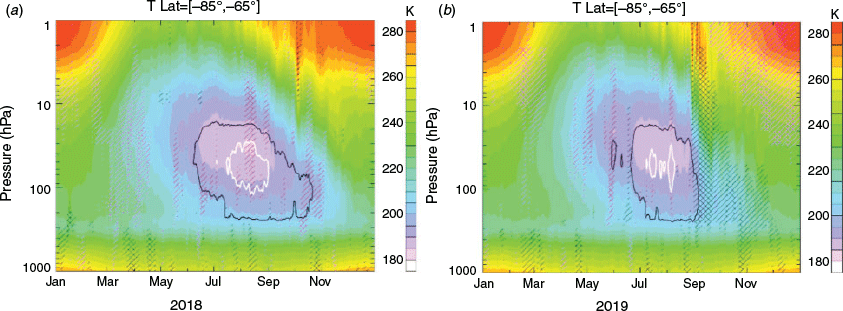
|

